A LEGACY OF LEADERSHIP
2009-2023

DARE TO BE TRUE SPRING/SUMMER 2023
BLAND YEARS
THE TODD
Milton’s 12th Head of School
With just six months remaining in his remarkable 14-year tenure, Todd Bland sat down in December for a formal portrait. The results, by photographer John Huet, appear on both the cover and in the feature story, by Marisa Donelan, on page 10. Bland’s signature bow tie, shown on the back cover, was shot by Milton faculty member Scott Nobles.

A Lasting Legacy
During both good times and challenging times in his 14-year tenure, Head of School Todd Bland brought the Milton community together.
Soft Power: A Defense Against Extremism 16

Engaging with Muslim communities around the world, foreign policy strategist FARAH PANDITH ’86 pioneered a new approach to ghting extremists and changed the narrative around how radicalization occurs and how to stop it.
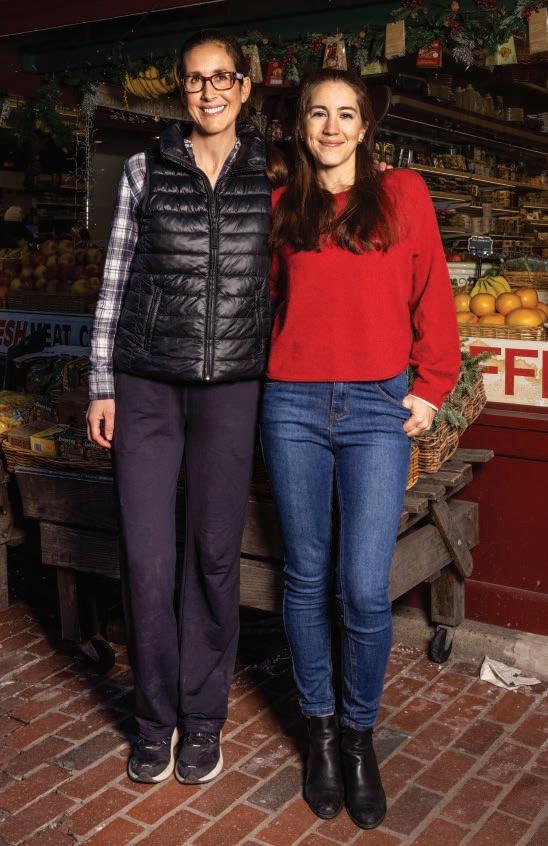
greg mably; alex gagne Milton Magazine
“We wanted this to have our families’ in uence and stamp on it but to also be our thing— a fresh generation and a fresh start for DeLuca’s.”
PAGE 22 On the Cover Contents Spring/Summer 2023 head of school 4 Leading with Love in the classroom 6 New Home for Math Features Quad . . . . . . . . . . . . . . . . . . . . . . 2 22
VICTORIA AIELLO ’08
SEE
. . . . . . . . . . . . . . . . . . . . . . . . . . . . . . . . . . . . . . . . . . . 10
A Fresh Start for a Family Business

CAROLINE AIELLO ’98 and VICTORIA AIELLO ’08, the new owners of DeLuca’s on Beacon Hill, feel a deep connection to the grocery store that has been in the family for almost a century.
Lesson Plans for Spaceship Earth

No stranger to generating new ideas, left a lasting legacy
HEAD OF SCHOOL
Todd B. Bland
CHIEF COMMUNICATION OFFICER
Eileen Newman
EDITOR
Sarah Abrams
ASSOCIATE EDITOR
Marisa Donelan
COPY EDITOR
Martha Spaulding
DESIGN
Modus Operandi Design
Patrick Mitchell
André Mora
CONTRIBUTING ARTISTS
Laurent Cilluffo

Pamela Fogg
Alex Gagne
Jimell Greene
Jason Grow
John Huet
Greg Mably
Scott Nobles
Brian Stauffer
Caroline Tomlinson
milton magazine is published twice a year by Milton Academy. Editorial and business offices are located at Milton Academy, where change-of-address notifications should be sent. As an institution committed to diversity, Milton Academy welcomes the opportunity to admit academically qualified students of any gender, race, color, disability status, sexual orientation, gender identity or expression, religion, or national or ethnic origin to all the rights, privileges, programs, and activities generally available to its students. It does not discriminate on the basis of gender, race, color, disability status, sexual orientation, gender identity or expression, religion, or national or ethnic origin in the administration of its educational policies, admission policies, scholarship programs, and athletic or other school-administered activities.
printed in the usa on recycled paper DARE TO BE TRUE SPRING/SUMMER 2023 On Centre . . . . . . . . . 34 . . . . . . 49
22
. . . . . . . . . . . . . 28
upper school ................. 36 Seeking Equity in Sports lower school ............... 40 After 24 Years, a Return to the Classroom in the news 44 Boys’ Soccer Wins ISL, First TEDxMilton Academy Event, Pete Colombo ’04 speaks at Veterans Day, and more ................... 50 60 .......... 61 63 ................... 64 16 Spring/Summer 2023 28
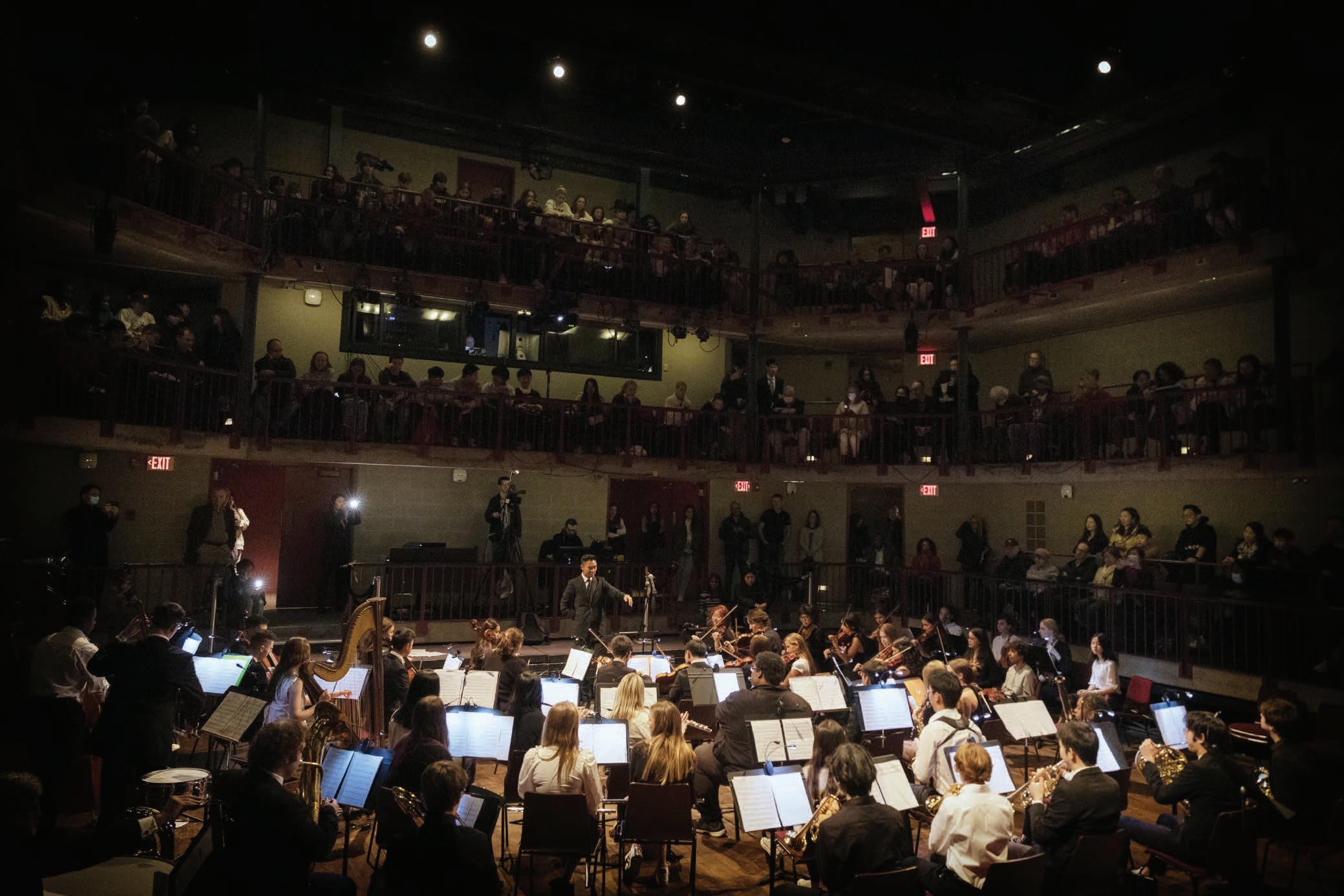
2 Milton Magazine

3 Spring/Summer 2023
LEADERSHIP
photograph by Michael Dwyer
& FACULTY PERSPECTIVES
A NIGHT TO CELEBRATE Milton’s Music Department chair, Adrian Anantawan, leads the Upper School orchestra at the Jean McCawley Winter Concert in December.
Leading with Love
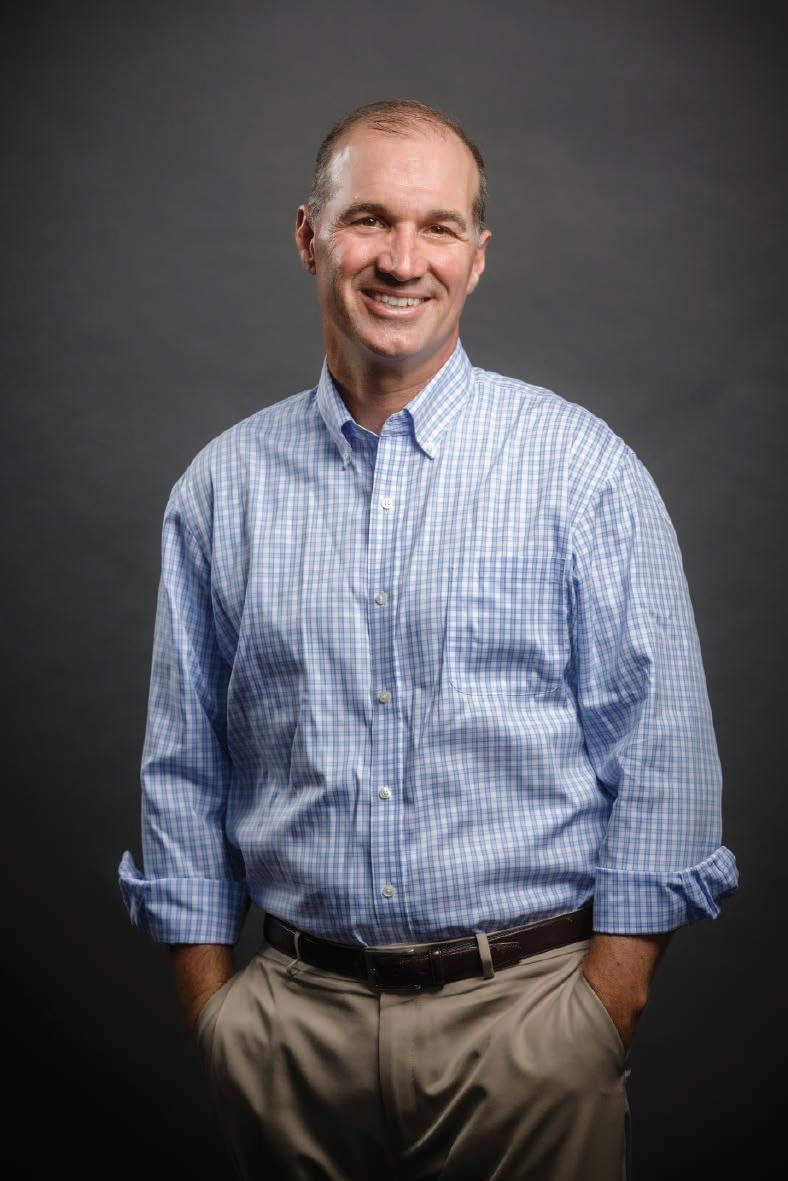
“Let’s go footba LL ! Go field hockey! Go soccer! Go cross country!” The pep rally leaders were a cyclone of energy, hyping up their peers to support the athletes about to compete that weekend. Then, without skipping a beat: “Let’s hear it for the robotics team! Give it up for speech and debate!” □
If the shift from athletics to and performance teams registered with anyone in the audience, they didn’t show it. Each group received raucous applause. For Milton students, recognizing athletic prowess in the same breath as other skills was seamless and natural. For me, it was one moment— out of thousands of similar moments—to witness something our students do with astonishing regularity and enthusiasm: celebrate each other. □ Every year since I became head of school at Milton, I have guesttaught in classes at all 13 grade levels. It’s not only a window into the transformative work of our faculty, it’s an opportunity to see our students in their truest form, as empathetic and compassionate young people who are as caring as they are smart, as generous as they are ambitious. As my time in this role nears its end, and I reflect on the lessons I take from this place, I know that the love students show one another has left an indelible mark. Their celebration in good times and their determination in hard times has made me a better leader and Milton a better school. Whether they’re packing theaters for performances or asking thoughtful questions around the Harkness table, Milton kids show up for one another. □ Milton has built an environment where students feel comfortable sharing their whole selves: their talents and interests, their cultural and family traditions, and their forays into new experiences. Students who enter the school planning to play three seasons of sports end up on stage in musical productions; kids with exceptional math and science skills find ways to express themselves in art. What feels remarkable about our school—and what fills me with hope for our future—is how ready and generous they are with praise for one another. They honor opportunities to learn from peers with differing life stories. Yes, they are competitive, as high-achieving
jason grow Quad Head of School
HEAD OF SCHOOL TODD BLAND DEPARTS MILTON WITH GRATITUDE FOR A COMMUNITY FULL OF GENEROSITY AND CARING
TODD B. BLAND , HEAD OF SCHOOL
students tend to be, but not at the expense of their classmates. They push themselves and root for others.
Students were the deciding factor in my coming to Milton. I had opportunities during my hiring process to meet the kids, to talk with them about the school and their interests. Their diversity, not just in their identities but in their passions and talents, was a critical hook for me. Even then, Milton had long been committed to enrolling a range of students from all walks of life— something we’ve continued to expand each year, and each one has something to teach all of us.
“Dare to be true” is more than a motto when it comes to this community. Milton students are honest and tenacious in the face of challenges and injustice. They come to our ongoing discussions about what diversity, equity, and inclusion mean at Milton with open hearts and open minds. Without the frank perspective of students of color, particularly Black and Latinx students, the significant progress we have made would have taken much longer or stalled completely. Similarly, transgender and nonbinary students have shared critical perspectives that have informed new policies and programs for students of all genders. The thoughtfulness, care, and commitment of all our students continually moves us toward a more inclusive environment. It’s not lost on me that for many of these students and the alumni who echo their stories, sharing experiences of not belonging or feeling unseen has been painful. I have tremendous gratitude for them and for the allies who have lifted their voices. One thing I
have noted while listening to these stories is that almost every single one of them is rooted in love: love for diverse cultures, love for one another, love for future generations of students, and love for Milton, even when it’s hard.

I often urge our students to love one another. Sometimes they cringe. Maybe it’s a little corny, and maybe it prompts some eye-rolls—especially from the teenagers—but there is no doubt in my mind that Milton students do love each other, whether they use the word or not.
In the ways that they encour -
age, fight for, and laugh with their peers, Milton kids fill this campus with love every day. Whether it’s our youngest students greeting others with hugs or our older students championing their friends’ unique identities and talents, I have been lucky to witness expressions and acts of love at Milton for 14 years. Even when they’re angry with each other or frustrated with the institution, they choose love. It’s a lesson I hope we can all take from these students: Keep loving one another. Keep loving Milton. I know I always will.
5 Spring/Summer 2023
“‘Dare to be true’ is more than a motto when it comes to this community. ”
i LL ustration by Greg Mably
A New Home for Math
MILTON’S MATH DEPARTMENT WILL EXPAND THE NUMBER OF CLASSROOMS AND MEETING SPACES IN ITS PLANNED MOVE TO THE CURRENT COX LIBRARY BUILDING.
a new space that fosters collaboration, innovation, and interdisciplinary learning, the Farokhzad Math Center will anchor Milton’s south quad, positioning math among the school’s spaces dedicated to arts, technology, and science.

The new center will move the Math Department from the cramped attic of Ware Hall to a modern, light-filled, renovated building currently occupied by Cox Library—which is moving to Wigglesworth Hall this year. The renovation will include an assembly space for 200 people, which will also serve as a forum for student exhibitions, faculty professional development, and informal gathering. Larger classrooms and flexible seating will make differentiated teaching possible, while breakout spaces will offer areas for study and collaboration.
The Farokhzad Math Center, supported by generous donors (see sidebar), will nearly double the school’s number of math classrooms and underscore the importance of math education for Milton students.
6 Milton Magazine credit
“
Now more than ever, mathematical literacy is central not only to our students’ success, but also to the economic success of nations.”
L
TODD BLAND
architectura
resources cambridge
Quad In the Classroom
MULTIMILLION-DOLLAR GIFT SUPPORTS MATH EDUCATION
As the parents of two Upper School students, trustee SHADI and OMID FAROKHZAD P ’23 ’25 know the importance of having a space that inspires a modern approach to teaching and learning. That’s why they have made a multimillion-dollar commitment to renovate the current library and transform it into a new home for math at Milton. “We chose to make a gift in support of a state-of-the-art mathematics building to provide students with the best possible opportunity to develop their problem-solving skills and curiosity,” the two say. “We are so happy to help to create innovative environments where young people can grow and develop skills and confidence as they learn.”
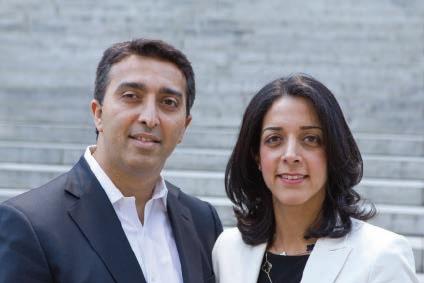
With their hearts set on making an impact at Milton through their leadership gift, the Farokhzads say, “It is our hope that our gift will inspire others to join us in supporting this effort.” To that end, the couple have issued a challenge to the Milton community: Invest $100,000 or more in the math center renovation, and they will match, dollar-fordollar, up to $4 million through December 31, 2024.
Milton is committed to ensuring that a premier mathematics education is a cornerstone for lifelong problem-solving. With construction on the Farokhzad Math Center scheduled to begin soon after Cox Library moves to Wigglesworth Hall in the fall of 2023, this bold vision will soon become a reality.
To include your name and legacy in this transformational facility, while also multiplying your philanthropic impact at Milton through the Farokhzad Family Math Center Challenge, please contact Milton’s Chief Advancement Officer, Lisa Winick, at lisa_winick@milton.edu or 617-898-2305.

7 Spring/Summer 2023
BUILDING A LEGACY

“If you’re going to live, leave a legacy. Make a mark on the world that can’t be erased.”
MAYA ANGELOU, AUTHOR
Building a legacy requires quiet determination and bold vision. The individuals featured in this issue possess those qualities, having brought new ideas, direction, and change into the lives of others and into their communities.
8 Milton Magazine
2023
SPRING/SUMMER

9 Spring/Summer 2023
illustration by Laurent Cilluffo
Story by Marisa Donelan
Photographs by John Huet
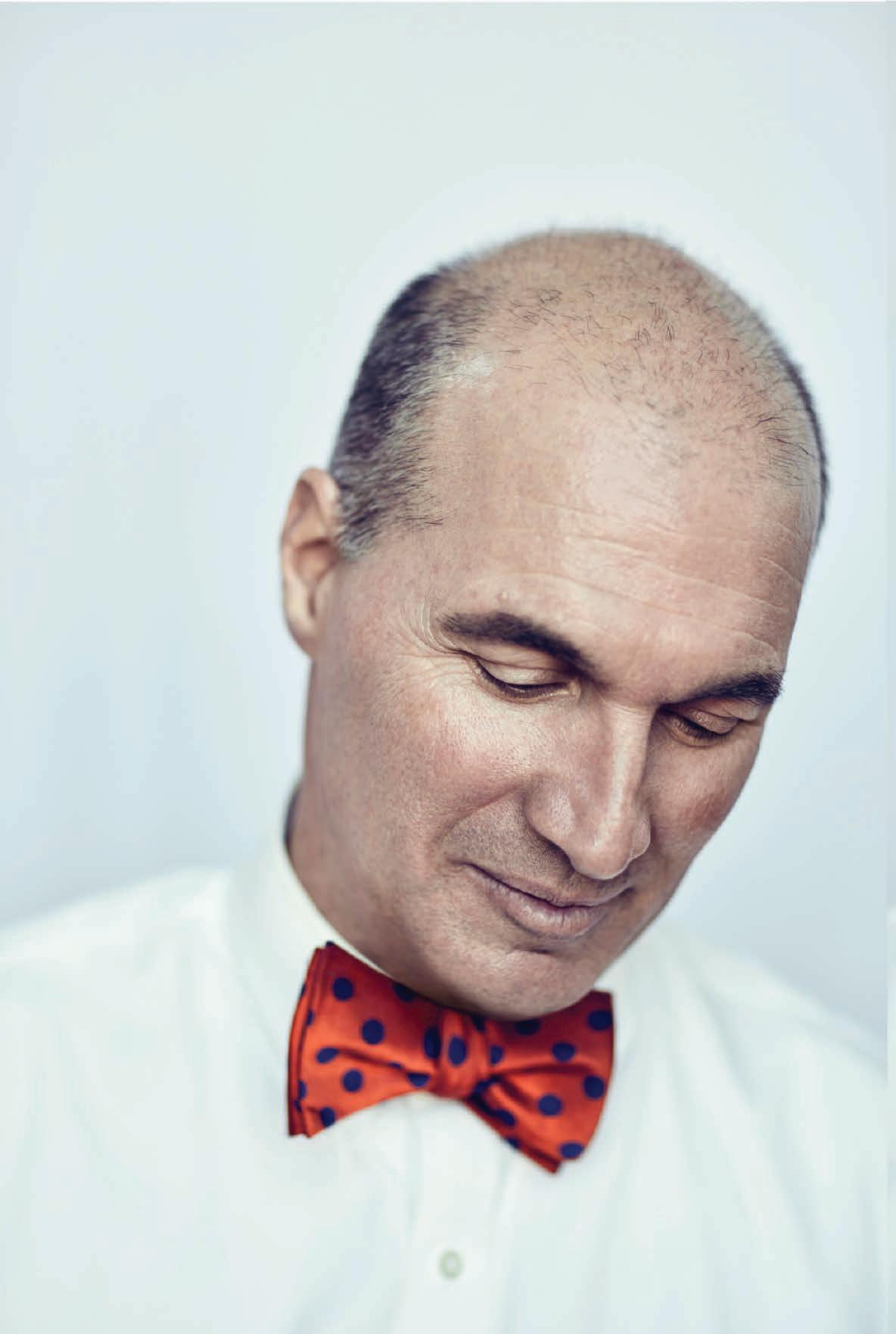
10
DURING BOTH GOOD TIMES AND CHALLENGING TIMES IN HIS 14-YEAR TENURE, HEAD OF SCHOOL TODD BLAND BROUGHT THE MILTON COMMUNITY TOGETHER.

11 Spring/Summer 2023
One
of the first tributes came during a night filled with laughter.
When “Dare to be Todd” flashed onstage before the final sketch of Wicked Sketchy, Milton’s irreverent annual comedy show, the packed audience might have expected some pointed jokes from the student performers at the expense of Head of School Todd B. Bland.
Instead, they got a wholesome, hilariously funny—and heartfelt—celebration of all things Bland: a parody of Lady Gaga’s “Bad Romance.” Bow tie–clad students sang and danced in honor of his 14 years at the helm of Milton Academy, a tenure characterized by an unrelenting focus on community and relationship building. For Bland, one particular lyric stood out: “Never worry alone.”
“That I would become synonymous with the phrase ‘Never worry alone’—well, nothing makes me prouder, even if it’s become a little bit of a joke,” he says. “There’s nothing more important to me than support, care, and love for others.”
Building connections and supportive relationships within the Milton community has been a central priority for Bland in his time as head of school, which will end in June. He arrived in 2009, a fractious time for Milton, which had weathered controversies both internal and external. A failed idea for restructuring Milton’s lower and middle grades had stoked anger among employees and families alike. Distrust was pervasive. Healing and care for the school’s people became a top priority.
“Never worry alone” became a watchword for the lifelong educator and school leader. To move forward, Milton people would need to
lean on one another. Bland has repeated the phrase over the years in difficult times: the covid -19 pandemic, an investigation into historical sexual misconduct at the school, and a reckoning with systemic racism at Milton and other predominantly white institutions. The best way to achieve progress, Bland reasons, is together.
“Someone once described the role of a head of school in three component parts: pastoral, financial, and educational,” he says. “There’s a lot more, but most of the work can fit into those categories. I think I had strength in all of them to a degree, but a lot of strength on the pastoral side. I have always felt that it’s so important in this role. And Milton needed a lot of love.”
This focus on people and relationships allowed Bland to lead Milton through an important yet tumultuous period in the school’s history. One of the hallmarks of his time at Milton has been his ability to surround himself with a strong, talented, seasoned team—he is quick to point out that the successes of his tenure are shared achievements.
else, reflecting back on my whole career, the ability to influence the life of a child is the most extraordinary honor. People did that for me, and it changed my life. I knew that if I could do that for other young people, my life would be wonderful.”
In addition to leading Milton, Bland has loved his roles in other education-focused organizations: He has served on the board of the Steppingstone Foundation, chaired the board of the National Network of Schools in Partnership, and is a trustee of the Epiphany School in Boston.
Bland is the middle son of two Milton graduates—JAMES BLAND ’58 and SHERRY DOWNES ’58. He and his two brothers spent their early years in Brunswick, Maine, where James Bland was an associate professor of history at Bowdoin College. Tragedy struck the young family when Todd was six and James died suddenly and unexpectedly. The Bowdoin community sprang into action, offering the family love and support even after they left Maine for Washington, D.C., to be closer to Sherry’s parents.
Over the course of his three decades as an independent school educator and leader, and during his youth, Bland was the beneficiary of care and personal investment from mentors, teachers, coaches, and friends who believed in him. From the middle school teacher who first encouraged him to run for a student government position to the school leader who tapped him for his first administrative role, their belief in his abilities gave him confidence. The opportunity to pay it forward— to do the same for the young people in his classrooms—was what hooked him on teaching and has kept him in education.
In his relationships with Milton students, Bland has done his best to be visible and accessible, spending time teaching at each grade level every year, and opening his door to any students who had questions or concerns about the school.
“I love being part of a school community, and I love the impact that I can see,” he says. “Above all
Bland attended St. George’s School in Rhode Island, where he was a prefect, a three-season athlete, and a lacrosse All-American. He describes himself as a hard-working student who excelled through middle school, then was hit with a “rude awakening” in his first year at St. George’s. He relates to students who are new to Milton’s academic rigor; during his tenure, Milton removed letter grades from the grade-nine transcript, a move designed to acclimate students to the school’s academic demands without discouraging them. Removing the letter grades helps them focus on improvement and growth.
When he became head of school, Bland also became a Milton parent. He and his wife, Nancy, have three children, all of whom graduated from Milton: NICK ’13 , and twins MAGGIE ’14 and EMILY ’14 . The experience gave him a front-row seat to how students move through the school, academically and socially. “It was incredibly instructive and helped me be the leader that I became,” he says. “I was more sensitive to the student experience as a result of living it with them.”
12 Milton Magazine
credit
john gillooly, michael dwyer, gregory white
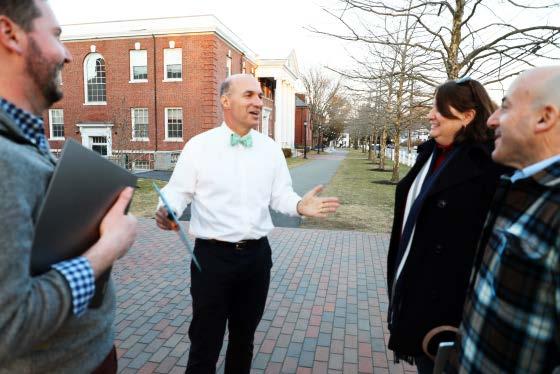


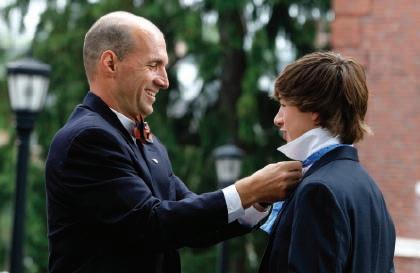



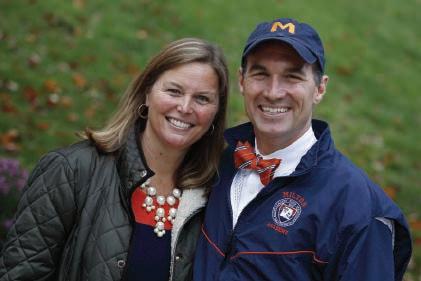



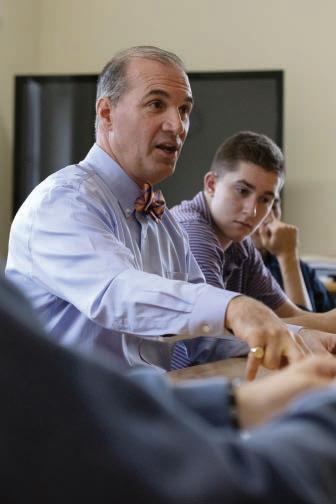
The Blands’ children have left the nest, starting their careers and adult lives after graduating from college. Nick and his wife, Philly, have a son, James. “There has been no greater source of strength, support, and resilience for me than Nancy and our children,” says Todd Bland.
selves so selflessly to our students,” he continues. “To serve them as head has been a great honor.”
Bland is proud of Milton’s administrative team, which has worked diligently to improve the school’s financial health, continually renewed curriculum at all grade levels, completed the most successful fundraising campaign in Milton history, and realigned its efforts for diversity, equity, and inclusion. The Dare campaign, which concluded in 2020, supported necessary capital improvements, faculty salary increases, and the implementation of a strategic plan. It raised $48 million for student financial aid, including the establishment of 44 new scholarship funds.
The campaign’s mission aligned with Bland’s leadership philosophy, placing top priority on investments in people.
“I’m very proud of the campaign and grateful that it happened during my tenure,” he says. “It’s representative of a lot of good work from a lot of people. We were able to raise the school’s philanthropic profile and raise money for human capital. That the school’s endowment grew is wonderful, but I’m even more proud of how we directed those resources.”
“I have always been inspired by the faculty and staff at Milton, particularly those who dedicate them-
Sound financial management by the Board and the school’s Business Office has allowed Milton to put money into its academic programs and professional development, something that’s reflected in the school’s use of space. The physical footprint of Milton Academy hasn’t changed much over the course of Bland’s tenure, other than the additions of the Pritzker Science Center and the Berylson Turf Field, but careful planning around how the school uses—and reuses— its resources has helped keep programs relevant to current students. New spaces in existing buildings have been dedicated, for example, to robotics and computer programming, visual arts, all-gender housing, and improved services for students’ physical and mental health. Future renovations will see Cox Library moving to Wigglesworth Hall and the Math Department moving into the library space.
“I have long believed that excellent institutions align their resources with their priorities,” Bland says. “And that seems simple, but many institutions don’t do that. They find themselves blowing a little bit more with the wind or a specific opportunity to raise money, as opposed to being very intentional about where they place their resources. We name our priorities first, and then we align our resources, and we’ve been very adamant that every endeavor we embarked on had to have a financially sustainable model before work began.”
Another source of pride for Bland is the way the school has responded to crises while prioritizing care for the people most affected. The covid -19 pandemic proved to be costly and stressful for schools, but steady resource management and redirection of funds toward added health and safety measures, as well as technology for remote learning, helped keep Milton’s programs going. Following a Boston Globe report about sexual misconduct in private schools, Milton proactively hired an outside firm to investigate incidents at the school, uncovering abuse in the 1970s and ’80s by a former faculty member who in 2022
pleaded guilty to criminal charges. Working with alumni survivors, the school has dedicated resources to healing and regular training to prevent misconduct.
The school in 2020 established a committee to study issues of race, bias, and equity at Milton; the group made more than 50 recommendations to the Board of Trustees, who adopted them all. Implementation of the recommendations—including an expanded Department of Diversity, Equity, Inclusion, and Justice and programs for students at all levels, employees, alumni, and families—is ongoing.
In the summer, Bland will hand the reins to ALIXE CALLEN ’88, Milton’s 13th head of school, and he takes seriously his responsibility for making it a smooth transition. He told the Board of Trustees about his plans to leave Milton nearly two years in advance so that they could engage in a thorough search for the next head. They found it in Callen, a Milton graduate who has led St. George’s since 2017.
Todd and Nancy Bland, who has worked at Milton in the Admissions Office and as a substitute teacher, plan to take some time to travel after they officially leave Milton. Neither is retiring; they are pausing to enjoy being grandparents and step off what Bland describes as “this very linear career trajectory we’ve had for 33 years.”
“We’ve had a great 14 years and we go with love and gratitude in our hearts. We’re just delighted to hand things over to a new leader.”
14 Milton Magazine
“Above all else, reflecting back on my whole career, the ability to influence the life of a child is the most extraordinary honor. People did that for me, and it changed my life.”
TODD BLAND
Bland, photographed in Milton's Apthorp Chapel in 2011. The chapel includes a plaque dedicated to the memory of James Bland ’58, Todd Bland’s father, who passed away when Todd was 6.

Soft Power: A Defense Against Extremism
ENGAGING WITH MUSLIM COMMUNITIES AROUND THE WORLD, FOREIGN POLICY STRATEGIST FARAH PANDITH ’86 PIONEERED A NEW APPROACH TO FIGHTING EXTREMISTS AND CHANGED THE NARRATIVE AROUND HOW RADICALIZATION OCCURS AND HOW TO STOP IT.
16 Milton Magazine
Story by Sarah Abrams
Photographs by Jimell Greene
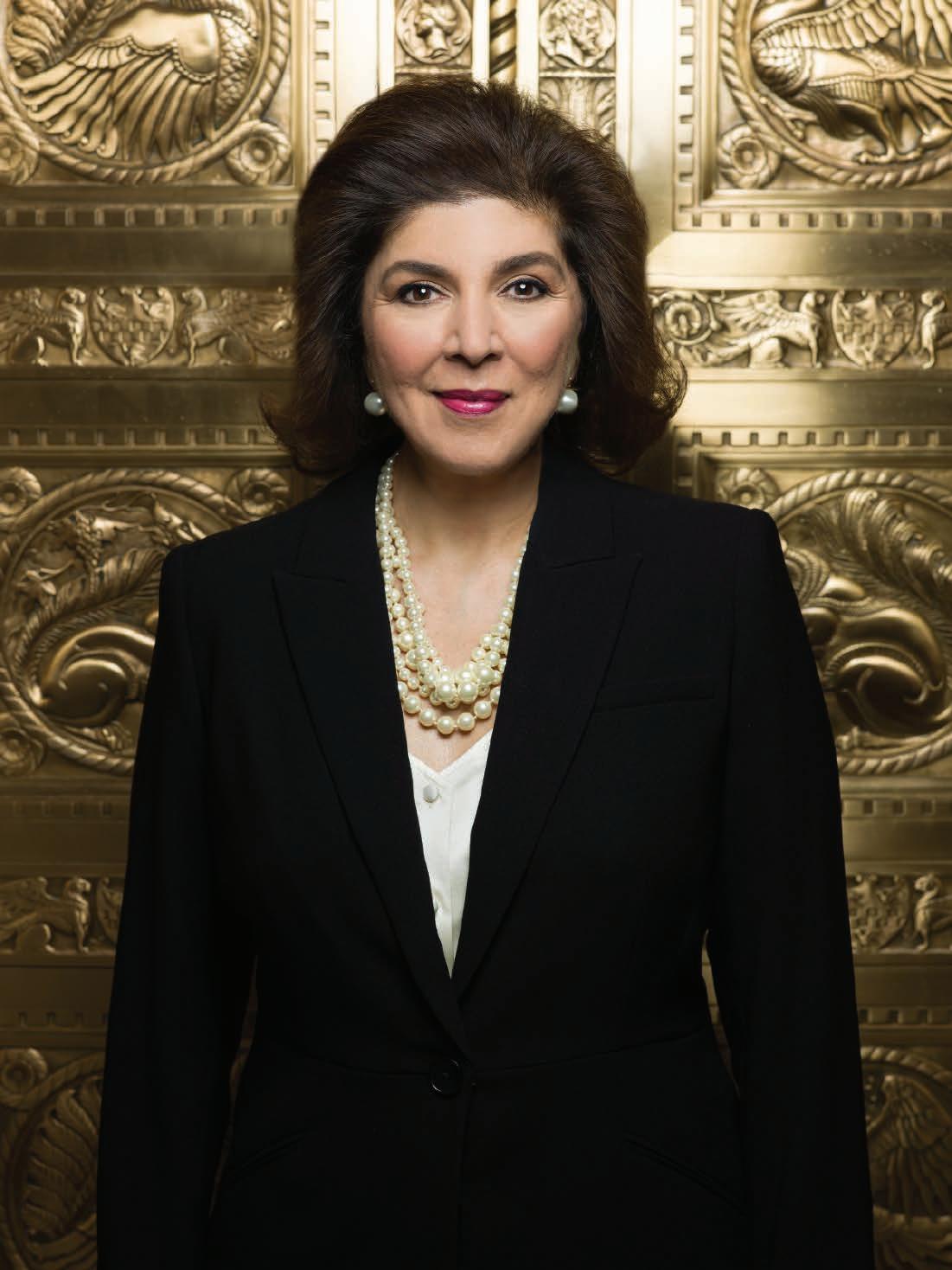
the day that set FARAH PANDITH ’86 on the path to becoming one of the United States’ top counter-extremism experts is one she will not soon forget. She was working in Boston at the law firm Mintz Levin as vice president of international business when Osama Bin Laden launched an attack on American soil, killing almost 3,000 people.
“9/11 was transformative,” Pandith says. “I walked into my boss’s office and said, ‘I’m an American; I’m a Muslim. Surely, there is something I can do to help our nation.’ Here’s this guy who’s trying to claim the mantle of my religion and saying, ‘America hates Muslims.’ For me, all the lies that spewed out of him were a call to action.”
By 2003, she was serving in the George W. Bush administration, first at the U.S. Agency for International Development (usaid), and then as director for Middle East Regional Initiatives for the National Security Council, where she worked on the “war of ideas,” the ideology behind violent extremism. She moved to the Department of State so that she could work closely with embassies. Traveling to communities throughout Europe, Pandith
Tand her team began a new kind of engagement, which included talking with individuals who had adopted extremist philosophies, and asking tough questions: “How are foreign concepts able to come into your community and convince you as a young 14-year-old or 17-year-old that you need to hate and that you don’t belong? What are the ideologies that they’re selling you?”
“Lots of theories existed then about why somebody would possibly decide to do something so horrific [as 9/11], but at the end of the day, we learned that it isn’t about education levels. It isn’t about what part of the world you’re born in,” Pandith says. “It turns out, you can be really well educated and really wealthy and still get radicalized. We see that today, too, with what is happening in America with the rise of antisemitism and hate of all kinds.”
A central component of how people get radicalized, Pandith discovered, was identity and belonging. She soon realized that change would not happen through government top-down solutions but by employing multilevel, soft power approaches: learning how to listen, engage, and build trust and understanding the importance of dignity and respect.
was deeply instilled in me at Milton. It was made very clear that you volunteer your time for something bigger than yourself; you think about the community around you; you do as much as you can to foster relationships. That effort to build understanding, to engage, to increase communication—I learned that at Milton.”
Born in Kashmir, India, Pandith attended Milton from kindergarten through high school. She felt a part of the Milton community from the start, she says. “I had wonderful classmates and rich friendships. Milton was not diverse at that time, but my classmates treated me like everybody else. I never thought about issues of identity ever.” As Upper School class copresident, Pandith was deeply involved in the school’s culture, representing her class to the administration.
“Those fundamental aspects of feeling confident about who you are—never thinking you are different, knowing you belong, having classmates and teachers who support your interests—help to make you who you are,” she says. “And I will tell you, that helped make me who I was.”
At the Council on Foreign Relations in Washington D.C., where she now serves as an adjunct senior fellow, Pandith talks about how the seeds of her work championing listening, engagement, and respect were planted at Milton Academy.
“A sense of public service really
Pandith’s commitment to serving a larger purpose followed her to Smith College. There, a speech on diversity she delivered as student body president led to her first government position. Her speech at the start of her senior year caught the attention of First Lady Barbara Bush, a member of the Smith class of 1947, who was in attendance. Pandith corresponded with the first lady throughout her senior year, and she was invited to the White House to discuss her future plans.
18 Milton Magazine
“I remember saying that I wanted a job that was international and one where I could make a difference,” says Pandith, who began working at usaid in the George H.W. Bush administration. “That’s how I got my first job,” she says, still surprised by the serendipitous nature of the start of her career.
Pandith later went on to earn a master’s degree at the Fletcher School of Law and Diplomacy at Tufts University, where she focused on security studies. For her master’s thesis, she interviewed militants involved in the struggles between India and Pakistan. “It was my James Bond summer,” she recalls. “I went in under the radar of the Indian government doing interviews, and I began to learn about extremism. It was fascinating.”
Her early work at usaid was foundational, Pandith says, for the work she would take on after 9/11 for the George W. Bush administration and later for the Obama administration. She expected her work to end when leadership changed hands, but in 2009, after briefing Hillary Clinton, the Obama administration’s new secretary of state, about the previous administration’s efforts to counter violent extremism, she was asked to join the new administration. “I briefed her on everything we had done, and she said, ‘You’re not going anywhere. I want you to do what you did, but I want you to do it around the world.’” Pandith was appointed to the newly created position of Special Representative to Muslim Communities.
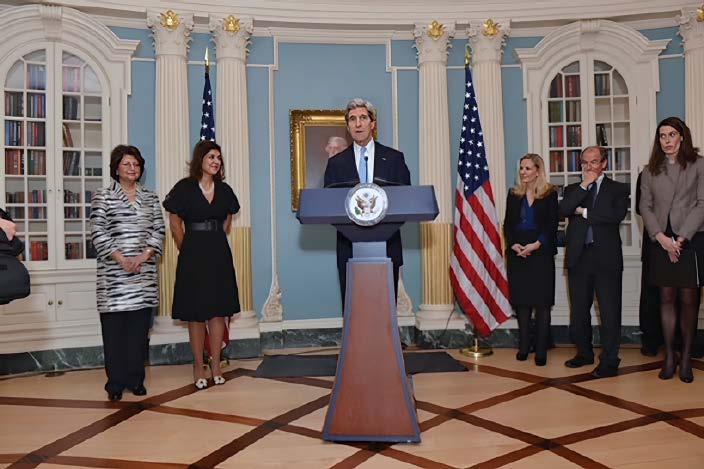

19 Spring/Summer 2023 courtesy of farah pandith
Farah Pandith ’86 at her farewell ceremony in 2014 as Special Representative to Muslim Communities with Secretary of State John Kerry. Pandith is an adjunct senior fellow at the Council on Foreign Relations in Washington DC, senior advisor at the AntiDefamation League, and a senior fellow at Harvard Kennedy School’s Belfer Center for Science and International Affairs. She is also the Muhammad Ali Global Peace Laureate.
KEEPING MILTON CLOSE
FARAH PANDITH ’86 has remained close to Milton, returning often for reunions and serving from 1998 to 2001 on the Board of Trustees. When the pandemic hit three years ago, she thought it might be a good time to reach out to classmates to see how they were faring. The result was the creation of a podcast called The Link (on Apple Podcasts) where 15 classmates have already shared their stories. Her cohosts are classmates DIANA DONOVAN, MEREDITH ZINNER, and DAVE YAS
Top photo: A Speech Team performance in 1985 with classmate closely with Pandith on the speech later quoted by First Lady Barbara Bush. Bottom: Pandith in 1984 with K—12 friend

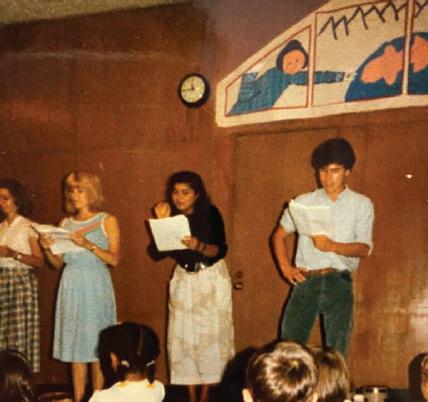
Traveling to almost 100 countries, she began scaling up and building out the kinds of soft power solutions she had learned mattered in her earlier work, deploying initiatives and programs to fight hate and extremism. She engaged, listened, and asked questions: What is happening in Mali? Is there any connection between what’s happening there and what’s happening in Indonesia? Do we see any synergy and understanding between a young person in Guyana and somebody in Norway?
As she had discovered in Europe, identity and belonging were central to how radicalization and extremism take hold. To stop radicalization,“we’ve got to think about it from the perspective of society and our shared cultures,” Pandith says. “Observe what’s happening within your community. What do you know that’s actually happening in a school, in a town, in a state? Understand it from the perspective of solving a problem through strategies that happen at the local level. It can’t just be the government that works on this. It’s got to be all of us. All of us have a role to play.”
preneurs, Political Visionaries, Enlightened Business Leaders and Social Media Mavens Can Defeat the Extremist Threat, which lays out the decades-long efforts of two administrations to counter extremist ideology. “Us-versus-them ideologies are a growth industry in America today,” Pandith says. “It is a serious national-security threat. What we are witnessing is unprecedented.
“Unlike September 12th, 2001, when we didn’t know what to do, solutions are now available and affordable. There’s now a national strategy for how to deal with these kinds of threats. There are systems in place on an international level that mobilize multilateral organizations. There’s a government response that is far more mature, and ngos are leading new efforts.”
And at the community level, Pandith says, “there’s a lot of creativity and desire that exists with people who have an interest in finding out ways to make their neighborhoods and communities less appealing to those who would try to radicalize.”

Almost 22 years after 9/11, Pandith believes societal change can happen. Many of the questions that have been asked about how to come together so that ideologies of hate don’t thrive now have answers, she says. The structure for fighting hate and extremism has become more sophisticated than it was on 9/11.
In 2019, Pandith authored How We Win: How Cutting-Edge Entre-
“Soft power gives us the tools we need to deal with making our societies more resilient to hate and extremism,” she says. “And treating people with respect despite their differences should not be a shocking and new thing. It should be fundamental to who we are. It should be ingrained in the way in which we operate. As someone who grew up feeling like I belonged, feeling recognized and respected by my classmates at Milton, when bin Laden attacked our country and tried to create a narrative about what America was, it made me very angry, because I knew what America was. I have lived it.”

20 Milton Magazine
courtesy of farah pandith

A FRESH START FOR A FAMILY BUSINESS

VICTORIA AIELLO ’08 AND CAROLINE AIELLO ’98, THE NEW OWNERS OF DELUCA’S, FEEL A DEEP CONNECTION TO THE BEACON HILL GROCERY STORE, WHICH HAS BEEN IN THE FAMILY FOR ALMOST A CENTURY.
 Story by Sarah Abrams
Photographs by Alex Gagne
Story by Sarah Abrams
Photographs by Alex Gagne
 Located among boutiques, restaurants, antiques shops, and antiquarian book stores, DeLuca’s Market, at 11 Charles Street, has been a mainstay for Beacon Hill’s residents, tourists, and workers at neighboring institutions.
Located among boutiques, restaurants, antiques shops, and antiquarian book stores, DeLuca’s Market, at 11 Charles Street, has been a mainstay for Beacon Hill’s residents, tourists, and workers at neighboring institutions.
when the sicilian-born Joseph DeLuca took over ownership of the Charles Street fruit and grocery store, in the 1930s, a gallon of milk cost about 32 cents and a loaf of bread 6 cents. Almost 100 years later, his great-nieces, CAROLINE AIELLO ’98 and VICTORIA AIELLO ’08, the market’s new owners, stand poised both to continue the grocery’s legacy as a mainstay in the neighborhood and to usher in a new era in a vastly changed world.

“We wanted this to have our families’ influence and stamp on it,” Victoria says, “but to also be our thing—a fresh generation and a fresh start for DeLuca’s—which I think every business inevitably needs.”

The idea of running the family business—a role passed on from one generation to the next, from their great-uncle to their grandparents to their father and uncles—was something, Caroline says, that has been simmering in the back of her mind since childhood. “For me, the store was always a source of such pride. It was an extension of myself. At Milton, I would always bring cannoli makings to share at the multicultural fair.” In French class one day, she recalls, her teacher was surprised when, during a class discussion on professions, she proudly shared that her father was a grocer. “He wasn’t sure how to respond,” she says.
The affection the sisters feel for each other and the ease with which they interact is palpable as they discuss their new venture.
Caroline is quick to praise Victoria’s athletic abilities, noting that her sister played competitive tennis at both Milton and Middlebury College, from which she graduated in 2012. “Victoria is an amazing

athlete,” says Caroline. And Victoria credits Caroline, an attorney who practiced international trade law for several years at Steptoe & Johnson, in Washington, D.C., with helping make the transfer in ownership smooth.
They began thinking seriously about joining forces, Victoria recalls, when Caroline visited her in Argentina during her junior year abroad. “The first time I remember it really entering the conversation was 2010 or 2011,” she says. “We would go to all these fabulous places and we’d say, ‘Oh, yeah, this could be DeLuca’s.’”
They always knew, however, that taking over the family business would not be a glamorous endeav or. “It’s a penny-margin business,” Caroline says. “We knew that going in. It’s a service business. It’s about continuing an important role in the community. Running a retail business—especially food—you’re serving the neighborhood; you’re serving your staff; but we also aim to be a must-visit spot for visitors to Boston. ”
The sisters plan to continue offer ing the high-end, specialty products from Italy—oils, cheeses, spices, and candies—that DeLuca’s is known for, but also to expand the store’s selec tion to include foods from around the world and to support wom en-owned and start-up businesses that are flourishing. “We’re really excited about having the opportunity to introduce all sorts of different foods—from ice creams and baked goods to healthy veggie chips and
Joseph DeLuca (top) in 1940. DeLuca was just 14 years old in 1914, when he began working as a stock boy at the Giuffre family‘s produce and grocery store on Charles Street. In the 1930s, he took over ownership of the market. Virgil Aiello, Jr. (above,right), who ran the business for many years with his brothers, Gerry and Robert (above),turned over the business to his daughters in January 2022.

25 Spring/Summer 2023 courtesy of the deluca family
chocolates,” Caroline says.
And everything must be of the highest quality. “We want to provide the best possible experience for our customers,” Victoria says. “We want to be really intentional and conscious about what we carry. Whatever type of food it is or where it’s from, it will be of amazing quality and, when possible, ethically and sustainably sourced.”
Meats will come from farms where the animals have been treated humanely. The sisters are looking at farms throughout New England. “We won’t buy from farms that take part in inhumane practices,” Caroline says. Produce will be sourced from local farms whenever possible, and they plan to phase out products that are overly reliant on plastics.
Plans are also underway to significantly expand the deli and prepared food sections. “Offering prepared foods that customers can take home and put on the table is the way we’re going to survive,” says Caroline. “In this new grocery climate, where people are buying online and can get everything delivered to their door, DeLuca’s will offer customers that human touch and also a really cool experience.”
Neighborhood customers are starting to notice the changes they are making, the sisters say. Shelves featuring a wide range of products—sauces, seasonings, and spices from around the world—are giving them a chance to prepare authentic international dishes properly, says Victoria. “Most recently, our younger customers have been excited to find ingredients to make the tinned fish board that’s a TikTok trend now. Our older clients, meanwhile, have been enjoying this
selection for years. It’s so rewarding to hear folks say, ‘Oh, look, they have this, this, and this.’”

Most of the products that have appeared on DeLuca’s shelves through the decades will continue to be offered. “There are a lot of folks who live in the neighborhood who are getting up in age and don’t have the mobility to go to Whole Foods, which is a 15-minute walk away,” says Caroline, “but they can come here. So we still stock their kind of tea and other specific things they want, like the Cream of Wheat that they are disappointed not to find.” “Or the saltless Saltine crackers,” Victoria adds. “It makes us really happy to do that,” says Caroline.
Virgilio Aiello, the sisters’ grandfather, in the early 1960s. After Joseph DeLuca’s death, their grandmother, Grace, and he continued the family business.
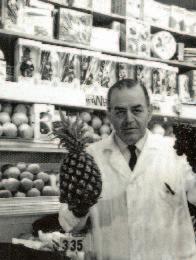
Although their parents never pressured them to take over the business, the sisters say, their father and mother, the artist Candace Jans, are delighted that they have decided to do so.
“They didn’t want to make us feel like we had to do this,” Caroline says. “They know how hard it is and they know the sacrifices you have to make.” Victoria adds, “But they’re happy we’ve decided to do it.”
Caroline already detects that same pride she feels for the family business in her two sons, eight-yearold Nick and six-year-old Geo. Nick enjoys stocking the shelves, Caroline says. Both attend school nearby and often stop in with their teachers and classmates to shop. “They’re so proud. They say, ‘Mom we’re going to run DeLuca’s someday when you’re done working.’”
The legacy goes on.
JOINING FORCES
Establishing their own careers before taking over the family business was important to making the new enterprise a success, say the sisters. In addition to practicing law in Washington, Caroline worked more recently with parents and children involved with the Massachusetts Department of Children and Families—work, she says, that she loved. Victoria worked in marketing at Women’s Health magazine in New York City and more recently at ESPN, where she coordinated marketing initiatives with the network’s offices around the world. “It was fun,” she says. “I think I satisfied the need for something vibrant and fast-paced.”
26 Milton Magazine
courtesy of the
deluca family
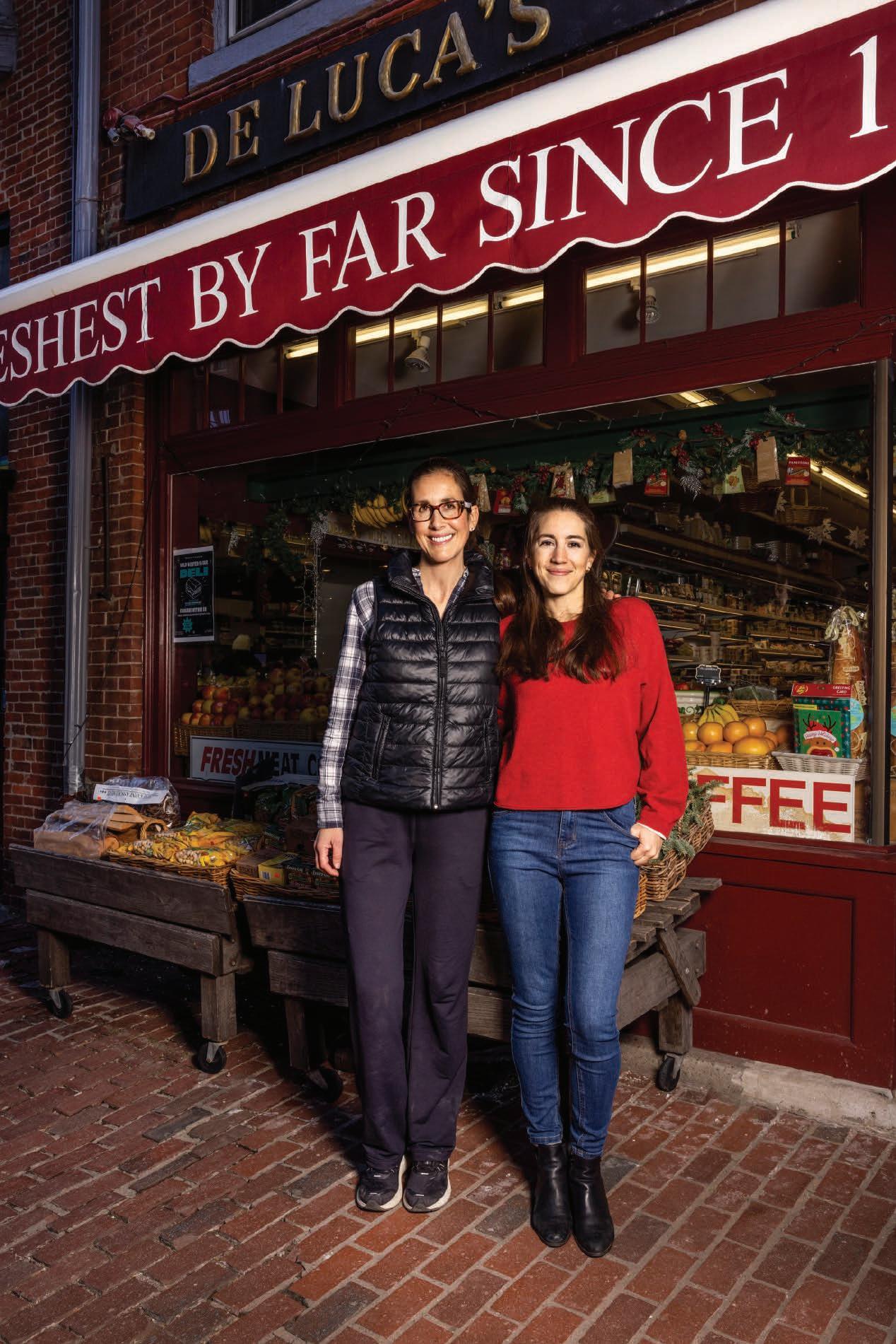
“In this new grocery climate, where people are buying online and can get everything delivered to their door, DeLuca’s will offer customers that human touch and also a really cool experience.”
CAROLINE AIELLO (LEFT) WITH HER SISTER AND PARTNER VICTORIA AIELLO IN FRONT OF DELUCA’S.

LESSON PLANS FOR SPACESHIP EARTH
NO STRANGER TO GENERATING NEW IDEAS, BUCKMINSTER FULLER 1913 LEFT A LASTING LEGACY OF HUMAN INGENUITY.

29 Spring/Summer 2023 courtesy of the r. buckminster fuller estate
Story by Steve Nadis
In 1966, a New Yorker article described R. BUCKMINSTER (“BUCKY”) FULLER 1913—one of Milton’s most famous graduates—as “an engineer, inventor, mathematician, architect, cartographer, philosopher, cosmogonist, and comprehensive designer.” An internationally renowned figure who wrote 28 books, held 28 patents, and earned 47 honorary doctoral degrees, Fuller offered a more succinct autobiographical description, calling himself “the world’s most successful failure.”
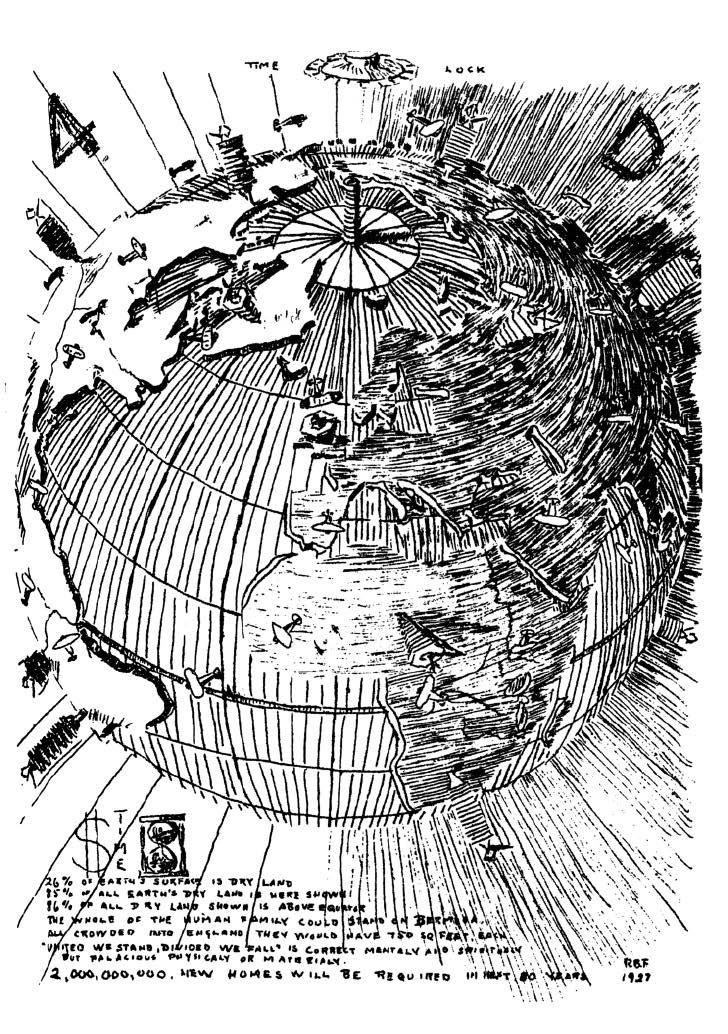
He might have said that because his most grandiose schemes never reached fruition—or at least not nearly on the scale he envisioned. In a career that spanned almost 70 years, Fuller concocted some pretty far-fetched notions that were, at a minimum, ahead of their time. They included flying cars; a city of a million inhabitants afloat in Tokyo Bay; a hemispherical dome two miles in diameter that would enclose central Manhattan, converting it into a climate-controlled paradise; communities built within giant craters that could house 25,000 families; fully submerged cities, anchored at sea, with delivery service provided by submarines; and, perhaps wackiest of all, floating cities, encased within balloon-like structures that would be so light, Fuller said, “they can be delivered by air.”
The fact that these propositions never got off the ground—or under ground or under water—did not slow Fuller down, because he had no trouble generating ideas. Although he lived, and fully embodied, the “life of the mind,” he was no ivory tower thinker. He applied his powers of cognition to practical problems— involving food, energy, shelter, and
30 Milton Magazine courtesy of the estate of r. buckminster fuller
“WE DON’T HAVE AN ENERGY CRISIS. WE JUST HAVE A CRISIS OF IGNORANCE.”
R. BUCKMINSTER FULLER 1913
Right: Top, Fuller in front of his “Moscow Dome,” which was designed for the 1959 American National Exhibit in Russia. Below, instructions for constructing the United States’ pavilion for the 1967 World’s Fair. Opposite page: An iconic drawing showing the recurring themes in Fuller’s career, most notably the constant consideration of the whole earth, which needs to be consciously viewed as an evolving meta-system.


transportation—and he was convinced that human resourcefulness could, ironically, solve problems of poverty and hunger that were commonly ascribed to resource scarcity. As he once said, “We don’t have an energy crisis. We just have a crisis of ignorance.”
The world’s greatest resource, he added, was not water, fossil fuels, mineral wealth, or abundant vegetation. It was human intelligence, ingenuity, and imagination. On that score, he surely contributed his fair share.
Fuller showed his promise early on, when his kindergarten teacher asked her students to make something out of toothpicks and dried peas. Young Bucky created an elaborate yet stable structure of interlocking triangles known as an “octet truss.” In 1961, around 60 years later, Fuller patented that design. He may not have considered his kindergarten feat particularly impressive, because he later remarked, “All children are born geniuses, and we spend the first six years of their lives degeniusing them.”
In 1904, at the age of nine—and by then, presumably, thoroughly “degeniused”—Fuller entered Milton Academy, where he would continue as a day student until his graduation in 1913. He claimed to have learned everything he needed for his subsequent engineering efforts from his Milton physics classes. He professed his debt to the academy in an inscribed photo that still hangs in the school’s admissions office: “To: Wonderful Milton Academy, where I learned how to organize thought and was urged to ‘Dare to be true’ to what I learned from organized thoughts.”
He was admitted to Harvard, but the experience did not go smoothly. After matriculating in 1913, he was expelled in 1914 and again in 1915— the second time for good. That ended his formal undergraduate training but marked the beginning of a lifelong, self-guided educational process. He also gained some valuable experience in the school of hard knocks, starting with his first job that same year for the meat-packing firm Armour and Company, in New York City, where he worked six days a week from 3 a.m. to 6 p.m. Fuller served in the U.S. Navy Reserve from 1917 to 1919, during World War I. He left his position at Armour in 1921 and took a job with a truck company until he was let go, a year later. He then struck out on his own as a would-be entrepreneur, but things did not go well. In 1927, he found himself 32 years old, unemployed, and broke, with a wife and a newborn daughter to support. He came close to committing suicide in the icy waters of Lake Michigan before an epiphany struck that set his life onto a new trajectory. If he committed suicide, he realized,
2023
A Spirited Three-Wheeled Debate
In the fall of 1978, BUCKY FULLER 1913 visited the Milton campus, where he met with two seniors, JUSTIN ABORN ’79 and DAVID RABKIN ’79. Aborn and Rabkin had been asked to show Fuller the three-wheeled bicycle they had designed and built. “Fuller proceeded to lecture us about how we had designed our vehicle incorrectly,” Rabkin recalls. “It should have steered by the rear wheel, he insisted, not by the front, which is how he designed his [three-wheeled] Dymaxion Car (above). That way, it could pull into parking spaces head on, without backing up.”
Fuller didn’t realize that the students couldn’t care less about parking their tricycle. They had built it to go fast, and it had reached speeds of 28 mph, which was not bad for a tricycle. “Unfortunately, we ended up in a standoff over our design objectives,” Rabkin says. “Which was a shame, because years later, I realized we had missed out on a great learning opportunity. Things might have gone better if we’d engaged him in a conversation about vehicle efficiency.” The students might have gotten an earful: Fuller was known to carry on for long stretches, sometimes talking nonstop for 12 hours or more.
Left, top: the finished threewheeled Dymaxion Car in 1933. Below: Fuller and his team constructing the first “ground- taxiing” prototypes, which came to be known as the Dymaxion Car. Opposite page, top: a drawing of the Dymaxion Dwelling Machine, which appeared in Fortune magazine, announcing Fuller’s first generation of mass-producible houses. Below, a model of the Wichita House/Dymaxion Dwelling Machine neighborhood.

“the inventory of knowledge that I had accrued would also be forever lost—an inventory of information that ... might prove to be of critical advantage to others.” Henceforth, he vowed, his life would be “an experiment to find what a single individual can contribute to changing the world and benefiting all humanity.”
For more than a year, Fuller livedwith his wife and daughter in the slums of Chicago, barely talking and instead immersing himself in reading and thought, filling notebooks with 2,000 pages of ideas that he hoped would propel him toward his newfound goals.
He started with a novel approach to home building. In his constructions, stability would be achieved not only by piling materials on top of a foundation and then on one another, but also through the “tensional forces” provided by cables or, say, the surface of a pressurized balloon. These elements came together in 1929 when he unveiled a model of the 4d House, subsequently renamed the Dymaxion House. ( “Dymaxion” is a contraction of dynamic, maximum, and tension—three words that Fuller was fond of—and he applied it to many subsequent endeavors.) Shaped like a pentagon, with windows on all sides, the Dymaxion House would be made out of metal and suspended from a central mast on steel cables. The home was intended to be transportable, and “airliftable,” to other sites. Ultimately, just one Dymaxion House was ever built—a dwelling in Wichita, Kansas, in 1946.
The first prototype of a Dymaxion Car appeared in 1933. It was a lightweight, three-wheeled vehicle, shaped like a blimp, that had a peri-
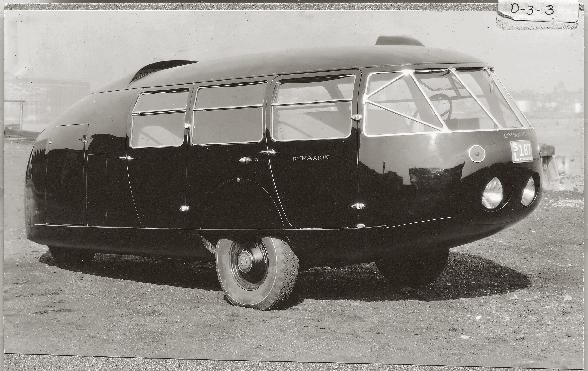
32 Milton Magazine courtesy of the estate of r. buckminster fuller
scope in place of a rear window. The original version could seat 11 people and attain speeds of 120 miles per hour. Fuller later changed his design to a five-seater, but neither version was ever manufactured commercially.
Altogether, 13 models of the Dymaxion Bathroom were assembled. Each was a self-contained, prefabricated unit including a sink, a toilet, and a bath that in theory could be installed as easily as a refrigerator. But production was terminated in 1936. Fuller had many gifts—and was widely heralded as a genius— but marketing was never his strong suit.
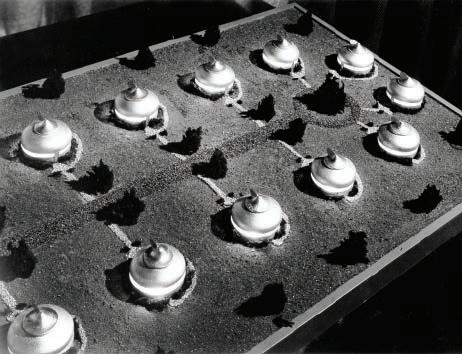
He had better luck with the geodesic dome—a spherical structure whose surface, like that of a soccer ball, is composed of flat polygons. The sphere appealed to Fuller because it has the largest volume-to-surface ratio of all three-dimensional objects and therefore could encapsulate more space with fewer materials. Another virtue of this design was that a frame’s strength automatically increased with size. With help from students,
Fuller built his first geodesic dome in 1948 at Black Mountain College, using the only materials then available—metal strips from Venetian blinds. But the strips were too flimsy, and the dome, which was 48-feet in diameter, immediately collapsed. Fuller, however, took its demise in stride, saying, “You succeed when you stop failing.”
Sure enough, the failure did stop: An estimated 300,000 domes have since been built—ranging from small playground structures to the 250-foot wide U.S. pavilion at the 1967 World’s Fair in Montreal.

In 1969, Fuller published a book that popularized the term “Spaceship Earth.” Those two words conveyed a potent image that changed the way many people viewed the world. If Earth truly is like a spaceship, then all the passengers have to work together to keep it running properly. “We are all astronauts,” Fuller proclaimed in a clarion call that promoted sustainable living practices, while simultaneously giving a boost to a burgeoning environmental movement.
Fuller didn’t lament the fact that
some of his wilder ideas, such as floating cities (“Cloud Nines,” as he called them), wouldn’t be built anytime soon, if ever. He still considered them an “exercise to stimulate imaginative thinking,” and in his view, there could be no loftier objective. If one could unlock the power of creative thought and direct that toward the common good, anything might
be possible. His remarkable life story was—and continues to be—a testament to that fact.
33 Spring/Summer 2023
STEVE NADIS IS A FREELANCE SCIENCE WRITER BASED IN CAMBRIDGE, MASSACHUSETTS. HE’S A CONTRIBUTING EDITOR FOR DISCOVER AND A CONTRIBUTING WRITER FOR QUANTA ; HIS ARTICLES HAVE APPEARED IN DOZENS OF OTHER MAGAZINES.
On Centre

34
Student Life at Milton

Spring/Summer 2023
illustration by Pamela Fogg
Seeking Equity in Sports
A NEW CONFERENCE ASKS INDEPENDENT SCHOOL LEAGUE ATHLETES TO BE LEADERS IN EQUITY AND INCLUSION. BY MARISA DONELAN
OLIVIA GREENAWAY ’22 fell in love with the game of squash in middle school after following her older sister into the sport. By the time she reached Milton’s Upper School, she was the only freshman to make it to the varsity team—and the only Black girl in the program—struggling both off and on the court.
“Even though I had always felt different from my teammates, by the time sophomore year approached, my inferiority complex was at an all-time high,” she told a group of Independent School League (isl) athletes, coaches, and diversity, equity, inclusion, and justice (deij) directors in November. “There was no amount of encouragement from friends or family that would alleviate the sense of anxiety that I had built up around my skill level.”
Greenaway, who is now in her first year at Columbia University, was delivering the closing address at the first-ever isl Changemakers Conference, held at Milton. Her advocacy as a Milton student for social change in athletics was one of the catalysts for the conference, which

welcomed select groups of students and adults from 15 ISL schools. Programs throughout the day included workshops on racially conscious leadership skills, equitable leadership, tools for interrupting biased language and behavior, and how privilege shows up in sports.
Activist, filmmaker, and former college athlete Byron Hurt was the conference’s morning keynote speaker. Athletes have a built-in level of status in the United States, and their behavior can set the social tone for a whole school, he noted.
“Because you are a leader, you have the potential to shape the direction of this country, to shape the direction of your school based on your status and your influence as athletes,” he said. “Why do you have some extraordinary opportunity for influence, wherever you are?
Whether we like it or not, whether we agree with it or not, whether we understand it or not, athletes have a very high profile in this country. And it’s really up to you to decide how to use your status.”
Invented in England in the 19th century, squash has earned a repu-
36 Milton Magazine
racial inequity.”
MELISSA LAWLOR
On Centre Upper School gregory white
illustration by Caroline Tomlinson

tation as a game of the white, male elite. Its unique court requires dedicated facilities and expensive equipment, and there are few free, public programs for new players to learn, Greenaway noted. In the United States, squash is disproportionately offered in private schools, which Greenaway explained are predominantly white and often enroll students from wealthier families. In her first years as an Upper School player, Greenaway felt isolated as one of the youngest players and othered by her racial identity. She overheard comments from teammates mocking Black visiting speakers and was asked to demonstrate a “Crip walk” (a move associated with a notorious Los Angeles street gang).
After a particularly rough patch during her sophomore year, Greenaway talked with her father about quitting the team. He encouraged her to keep at it. She raised her concerns with her coaches, who comforted her and called a meeting with the team to discuss its dynamics. Things felt more welcoming after that, until, while watching a match, she felt something delicately touching her hair: The mom of a white teammate was petting her box braids.
The covid -19 pandemic interrupted isl sports for most of the 2020–2021 academic year, which meant that Greenaway’s junior squash season was canceled. Before returning senior year as a co-captain, she established the school’s Diversity in Athletics Student Board to start the conversation about inequity in sports at Milton and beyond. Working with faculty member Molly Swain and others, Greenaway suggested expanding the conver -
sation beyond Milton.
In the meantime, Milton hired Melissa Lawlor as the first-ever Upper School director of equity in the newly established Department of Equity, Inclusion, and Justice. Lawlor, a former college athlete, had organized a similar conference in her previous job in New Hampshire. Milton’s Athletic Director Lamar Reddicks is the dei commissioner for the isl, Lawlor noted, so Milton made sense as the inaugural host for the event.
“The feedback was amazing,” Lawlor said after the event. “Universally, the kids wrote in how much they had craved conversation across the league. They loved this concept of coming together as one team to tackle issues of racial inequity.”
Lawlor recalls being one of only three athletes of color on one of her college teams. Although her white teammates were kind and caring, she felt that she didn’t have the power to speak out about things that made her feel isolated.
“Half the battle is getting kids to realize that they have that kind of power as athletes and what they can do with that kind of power,” she says. “Do they just sit on it and perpetuate the status quo? Or are they going to be the ones to put their social capital on the line? Because that’s real allyship if you are willing to put something on the line for someone else who might not feel comfortable using their voice.”
In the fall of 2021, the Diversity in Athletics Student Board was up and running at Milton, Greenaway says. They had four areas they wanted to investigate: equitable access to sports for students whose families couldn’t afford expensive
equipment and private training; interscholastic conversations about sports equity; the allocation of athletic funds to various sports teams; and diverse representation for underrepresented student-athletes.
“These social biases are not unique to Milton—they are reflective of a problem that permeates all educational institutions,” she says. “We need to have uncomfortable conversations that inspire athletes and coaches to take long, hard, introspective looks at the shadow aspects of our schools.”
When her senior squash season came around, Greenaway and co-captain RHEA ANAND ’22 were the leaders of a more racially diverse team, which captured the ISL title and ended up ranking 12th nationally. Greenaway herself felt more confident, which was reflected in wins on the court. “Having more athletes of color join the team reminded me that I, too, belonged, and was worthy of succeeding,” she says. Today, she belongs to a women’s league at StreetSquash in Harlem, a nonprofit program that provides urban youth with athletic opportunities, academic enrichment, community service, and leadership development.
Seeing the Changemakers Conference come to fruition so quickly after the idea sprouted was wonderful, says Greenaway, who credits current and former Milton faculty like Lawlor, Reddicks, and Swain, along with Vanessa Cohen Gibbons, Chris Kane, and Heather Flewelling for supporting the efforts that led to the event. “I hope that all the attendees left the conference feeling inspired and ready to spark change in their communities.”
38 Milton Magazine john gillooly
“Having athletesmore of color join the remindedteam me that I, belonged,too, and was worthy of succeeding.”
On Centre Upper School
OLIVIA GREENAWAY ’22 (PICTURED, OPPOSITE)

After 24 Years, a Return to the Classroom
MUCH HAS CHANGED IN THE 24
Gretchen Johnson remembers her first days as a fifth-grade teacher in Milton’s Lower School. After spending several years just out of college working in marketing for the Boston Celtics and Bruins, she was ready and eager in 1995 to put her training in early education into practice.
“I dove right in,” Johnson says, about those early years coteaching fifth grade with longtime Milton faculty member Scott Ford. “I don’t think I realized how much I would love it until I really was in it. I found the students to be just so refreshing and straightforward. In the corporate world, everyone is very careful about what they say. Engaging with fifth-graders is so uplifting. That was the first ‘wow’ for me and it ran throughout the year.”
Johnson taught for several years, until in 1998, her passion for writing took her into the magazine world where she worked for Inc. and Boston Magazine. She also expanded a tutoring business she had begun in the summers while teaching at Milton. Miller Academy (Miller was her last name at the time) was
a thriving business for many years as she married and raised a daughter. It also helped keep her up to date as theories and practices around education evolved.
Having returned to Milton two years ago, first as a Middle School learning specialist and then, in 2022, as a fourth-grade reading and writing teacher, Johnson is delighted to be back in the classroom. “I had been on my own as a tutor for a long time,” she says.” After a while it can get a little lonely. When I learned after all these years that I would be teaching fourth-grade reading and writing, it was like a dream. The fourth and fifth grades were always my sweet spot.”
Twenty-four years after leaving Milton, Johnson marvels at the preponderance of teaching and learning options now available to teachers and students. The internet, which was just becoming mainstream in the 1990s, has opened up a wealth of new avenues. Through Google Classroom, students can access homework assignments, correspond with her, and find supplementary resources (videos, articles, etc.) that support
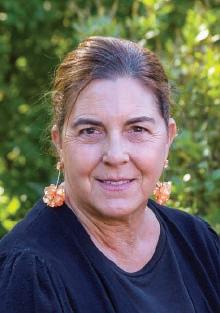
40 Milton Magazine courtesy of gretchen johnson
“In the corporate world everyone is very careful about what they say. Engaging with fifth-graders is so uplifting.”
GRETCHEN JOHNSON
YEARS SINCE GRETCHEN JOHNSON FIRST TAUGHT AT MILTON, BUT SOME THINGS NEVER DO. BY SARAH ABRAMS
On Centre Lower School illustration by Brian Stauffer
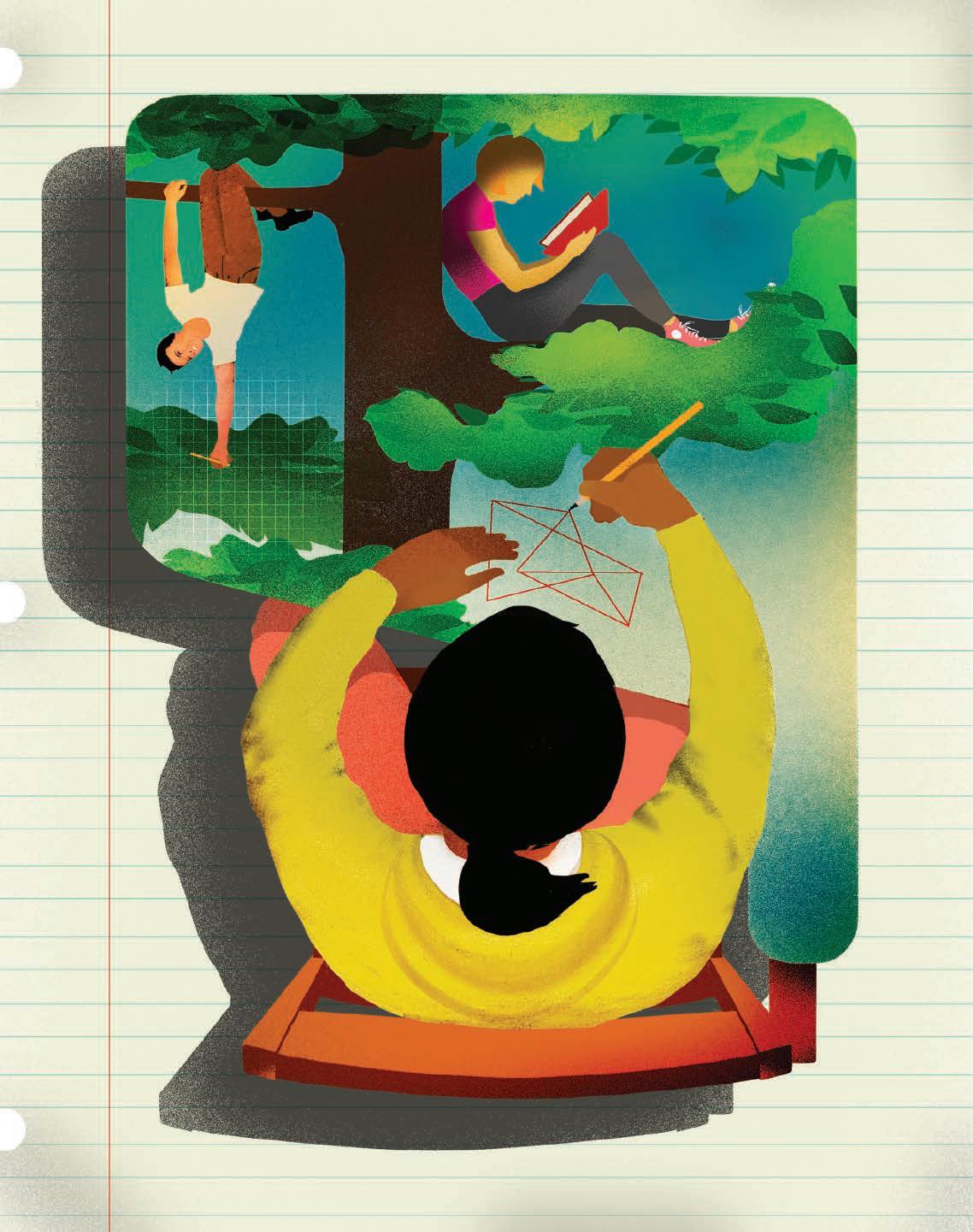
their classwork.
Johnson makes certain, however, to incorporate balance in each day. “You have to be mindful, like with anything, to make sure that you’re not overdoing it with technology,” she says, “and that you’re weaving into the day traditional books and artwork with crayons and markers and actual paper. Instead of ‘I can do that on Adobe,’ I will often say, ‘No, let’s close the iPads, I’m going to read a story to you while you listen or draw.’ They love that. They actually do love to unplug.”
Johnson is also pleased to see that as greater sensitivity to learning differences has emerged over the past several decades, these differences have become very much a part of the conversation. “If a student has been diagnosed with dyslexia, or they need extra time, we have a team of specialists who work with the homeroom teachers and parents,” she says. “That’s an amazing difference. We’ll teach kids the way they learn best, whether it’s visually or auditorily or kinesthetically.”
And students have become advocates for themselves, she says. “They know those resources are there for
Johnson was delighted in 2022 to return to the classroom as a fourth-grade reading and writing teacher. “The fourth and fifth grades were always my sweet spot,” she says.
them and they’re not afraid to speak up. There’s no stigma attached, which is empowering for the students. They come to school excited because they know that if they sense a roadblock at all, we’re going to figure out a way to make things work for them so they can flourish, move forward, and feel empowered.”
The increased focus on cultural sensitivities—on diversity, equity, inclusion, and justice (deij)—has also been wonderful to see, Johnson says. “All of last summer’s reading books had themes woven in throughout about standing up against bias, about standing together, and about teamwork and solidarity. All these messages that are so positive and are woven through the deij curriculum across the campus—starting as young as kindergarten—are huge.”
Advances in awareness of learning and cultural differences—as well as the emergence of new teaching methods and tools over the past several decades—are not all that has changed, says Johnson. “Twenty-four years later, having all those years as a teacher and tutor working one-on-one with kids, I’m a very different person. Also, now being a mom, I’m often looking at my students through the lens of a mom. I have that hat on all the time as I teach.”
What hasn’t changed is her enthusiasm for the work and the curiosity and exuberance of her students. “I have a lot of energy, but teaching is energizing me even more than I thought it would,” she says. “When I come in in the morning, the kids are so sweet. It’s a lot of give and take. You know you’re helping to make their day and they are making your day. It just puts a smile on my face.”

42 Milton Magazine john gillooly
“You have to be mindful, like with anything, to make sure that you’re not overdoing it with technology and that you’re weaving into the day traditional books and artwork with crayons and markers and actual paper.”
GRETCHEN JOHNSON
On Centre Lower School

43 Spring/Summer 2023
In the News
Boys’ Soccer Wins ISL
Up until its final game of the year—the New England finals against Worcester Academy— Milton’s boys’ varsity soccer team was not just undefeated: It had never been behind at any point in the season.

Crowned Independent School League champions after a 14–0–1 ISL season, the team’s overall 2022 record was 15–0–4. Going into the NEPSAC Class A finals, Milton beat Exeter 3–1 in the quarterfinals. Milton then beat defending champions Northfield Mount Hermon by penalty kicks to advance to the finals against Worcester. The match again came down to penalty kicks, but Worcester prevailed.
“The end of the season was exciting throughout,” says head coach Chris Kane. “In the finals,
Worcester scored a couple minutes in, but our group did a great job responding and scored a little bit before the end of the half, then a second time just before halftime. We were up 2–1 going into the half. Worcester scored again before it went into overtime. We just came up short on penalty kicks, but it was a great, fun season ending in a thrilling set of games, as close as you can get.”
Led by cocaptains MATEO BUYU ’23, JACK FLOWERS ’23, and NIK KATHIRESAN ’23, boys’ soccer was the only Milton team to have a postseason showing this fall. Seeded no. 2, Milton hosted the quarter- and semifinals on campus, which provided the players with a lot of fan support. In addition, the boys received
a lot of love from alumni who had played for Milton (such as assistant coach CHRIS LEWIS ’15), making the squad feel like an extended family, Kane says.
“It was a fantastic season overall, and I’m certainly so proud of the group for all that they accomplished and the way they went about it,” Kane says. “Not only did they improve a lot and grow throughout the season, but they had a lot of fun. They brought great joy to what they did, great love for the game and love for one another. And they used that as fuel to keep getting better and play some fantastic soccer.”
Buyu was selected for the high school All-America East team, and Kane was tapped to coach the team.
44 Milton Magazine SPORTS
michael dwyer, gregory white
Alba Gilabert-Reid ’26 Featured on NPR

Heyburn Lecturer Elizabeth Hinton Discusses Race and Protest
Acts of rebellion and resistance in American social movements have received vastly different responses from police and mass media—according to the race of the the protesters—since the foundations of the country, this year’s Heyburn lecturer, Elizabeth Hinton, told Milton students in November.
Hinton, an author and Yale professor who researches poverty, racial inequality, and urban violence in the United States, described the history of Black protest movements and their characterization as “riots,” even when they were peaceful in origin. To understand the disproportionate response to Black social movements, she said, we have to look at the history of policing in America and its roots in racial oppression.

45 Spring/Summer 2023 STUDENT NEWS
ALBA GILABERT-REID ’26 shared her musical talent on NPR’s From the Top in October. From the Top is a nonprofit program
SPEAKER
Aimee Nezhukumatathil Visits as Bingham Writer

Upper and Middle School students enjoyed a visit from poet and essayist Aimee Nezhukumatathil, the fall’s Bingham Visiting Writer, who told them, “Wonder is when you’re learning and it makes you smile.” She spent time in classrooms with creative-writing students and shared some of the work from her collection World of Wonders: In Praise of Fireflies, Whale Sharks, and Other Astonishments.
Flood-Marr Trophy Returns to Milton After 40 Years
Defeating Kimball Union Academy 3–1, Milton’s boys’ hockey team won the 57th annual Flood-Marr Tournament in December.
The tournament is named for Dick “Lefty” Marr and his college roommate, longtime friend, and rival hockey coach Dick Flood. Lefty Marr was a member of the Milton faculty from 1957 to 1980. The three-day competition for boys’ teams includes Milton, Nobles, Hotchkiss, Andover, Westminster, Deerfield, Kimball Union, and Salisbury.
Girls’ varsity hockey made an impressive showing the same weekend in the 41st Harrington Invitational tournament, getting to the championship round for the first time ever. The girls faced off against Nobles, Lawrence, St. Paul’s, St. Mark’s, BB&N, Westminster, and Williston-Northampton. They ultimately lost to Williston-Northampton, placing second.

46 Milton Magazine On Centre In the News david arnold,
white SPEAKER
marisa donelan, gregory
SPORTS
you tonight.”
The school’s Alumni and Development and Student Activities offices supported the student

Pete Colombo ’04 Returns as Veterans Day Speaker

harder to honor the humanity of their patients, many of whom were hooked up to lifesaving machines and were isolated
organization and can be hosted by any group. Milton’s talks will be shared through the TEDx You Tube channel.

47 Spring/Summer 2023 EVENTS
SPEAKER
Milton welcomed Army Maj. PETE COLOMBO ’04 back to campus as the 2022 Veterans Day speaker. Colombo spoke about his journey from playing football at Milton
Jean-Charles ’96 at MLK Day Celebration
Professor, author, and Milton grad and parent
RÉGINE JEAN-CHARLES ‘96 led Milton’s celebration of Martin Luther King Jr. Day. Jean-Charles’s speech to Middle and Upper School students reminded them to look beyond a single story about Dr. King’s life and work and to seek to build a better world.
In an evening gathering for the community, Jean-Charles read from her book Martin Luther King and the Trumpet of Conscience Today, while students shared speeches and poetry. The audience also enjoyed performances by dance team Ritmo, the Jazz Band, and Gospel Choir.

OBSERVANCE
gregory white

photograph by 49 Spring/Summer 2023
News & Notes from Our Alumni Community
Alumni Life
Mae Ryan ’02 and Steven Grisé exchanged vows on a pond at their home in the Hudson Valley.
1950
NANCY (BURLEY) CHASE, loyal alumna and parent, passed away on October 30, 2022, at age 90. As a student, she sang in the Glee Club and was captain of the lacrosse team. She went to Skidmore College, graduating in 1954 with a B.S. in nursing, and began her career as a public health nurse with the American Friends Service Committee in rural El Salvador. Nancy served as the executive director of the Milton Visiting Nurses and co-founded Milton Meals on Wheels. When her family moved to Epping, New Hampshire, she became the executive director of Seacoast Hospice in Exeter, New Hampshire. Nancy’s many interests included gardening, flower arranging, quilting, playing Scrabble, and sailing along the Maine coast. Nancy was predeceased by her husband, Jack W. Chase, and her partner of the past 19 years, Graham J. Ross. She is survived by her two sisters, SALLY (BURLEY) BECK ’48 and JANE W. BURLEY ’69;

her four children, THOMAS CHASE ’77 and his wife, Joanne, SARAH CHASE ’79 and her husband, Keith, MELISSA CHASE ’83, and JOSEPH CHASE ’85; and nine grandchildren. Nancy and Jack attended many Milton plays, concerts, and sporting events with enthusiasm. Often class secretary and on reunion committees, Nancy kept close ties with her classmates throughout her life.
1951

NANCY “NANINE” (POWELL) RHINELANDER reflects as the oldest and first in her girls’ class to turn 90 and thinks all who attain 90 deserve an award plus many more years of health.

“Keep on truckin’!”
1952
KITTY (BIGELOW) BENTON moved to Laurelmead, a senior coop in Providence, Rhode Island, in December. It will be a huge change after spending
most of her life in New York City, but she looks forward to making new friends, enjoying Lau relmead’s beautiful swimming pool, the cozy library, and practicing billiards with her grandsons. She also looks forward to being neighbors with her daughter EMILY (BENTON) MORGAN ’80.
1953
HUGH MARLOW is looking forward to joining classmates for the 70th Reunion. He adds that a plus is to see the majority of the younger alumni who return to share their accomplishments.
1956
JOHN BASSETT writes that he has been performing a lot of music lately. He is currently in three bands, including Too Klez for Comfort. John has also been sculpting art from recycled glass bottles. You can view his work at www.basglas.com. John is still volunteering in the Brookline town government. He also has written a lot of letters to his good friends in Georgia and Pennsylvania.
RUPERT HITZIG shares that he is still alive! His heart goes out to those classmates who have taken their final journey. He will miss them. He is currently working “or rather playing, ‘cause that is what my life has been.” Rupert was once a Marine and rode across the U.S. on a horse while at Milton (109
days in the saddle at 15)! After his days at Milton, he went on to Harvard. Then he traveled to Hollywood, Paris, Rome, London, and around the world with the Joffrey Ballet. Rupert produced and/or directed movies and television shows including Saturday Night Live, a game show in Paris, and many videos in support of charities. He “married the right woman 53 years ago.” They share two sons, three grandchildren, and a host of memories. Rupert notes that, “I owe a lot to Milton, and the classmates I met there are still my best friends. I feel good, have been happy most of my life, and would love to do it all over again. Through all the ups and downs, I think I have DARED TO BE TRUE!”
50
BIRTH BOOK RELOCATION WEDDING
Nancy (Burley) Chase ’50
ICON KEY Milton Magazine Class Notes 1950–1964
1953
ELIZABETH “BETTY” HILLS, ALEXANDRA “SANDY” (BOYD) EARLE, and JANE (CHEEVER) CARR enjoyed catching up over lunch in the fall.
PHILIP RAND took a trip to Australia in late December that lasted until mid-January.
1958
NEILSON ABEEL and his wife, Tori Bryer, hosted a lunch in October at the Tavern Club in Boston with SHERRELL “SHERRY” (BINGHAM) DOWNES, EDWARD “TED” E. WENDELL, JR., Mary Wendell, and NATALIE “TALLY” (SALTONSTALL) FORBES all in attendance.


1959
PHILIP “PHIL” H. KINNICUTT and Marcia Schoeller have resumed their travels and spent the past few months “going to class” to prepare for their planned “Tanzania Adventure” this summer. The small-group college alumni tour, which includes Zanzibar and a visit to Serengeti National Park, has provided an extensive reading/resource list of literature and history books suitable for a college course syllabus. Phil writes that they are really excited about the upcoming “safari” and are enjoying their life in Florida.
DEBORAH “DEBBY” C. ROGERS currently resides in Des Moines, Iowa, at Wesley Acres, which is undergoing a massive renovation. As for her family members, Ellen resides in Milton as a photographer and Elizabeth resides
FAITH (MORROW) WILLIAMS is currently living in Scottsdale, Arizona, at Westminster Village, near her youngest son, Nick, and his family. She writes, “There are guest rooms here, and it’s in a lovely climate, great to visit.”
1960
CHARLES “CHAS” FREEMAN remains active on the lecture circuit in the U.S., Asia, and Europe, including acting as a visiting scholar at Brown’s Watson Institute for International and Public Affairs and a frequent commentator on foreign affairs. He will now do these things from Exeter, New Hampshire, where he and his wife moved at the end of September from Washington, D.C.
1957 MARTHA (DAMON) MARSHALL, second from right, and LISA (GRAVES) WARDLAW, right, were the two alumni from the Girls’ School to attend their 65th reunion last June. They greatly enjoyed being back on campus after all these years and were sorry not to see more classmates there to celebrate as well. Here’s to the next reunion in 2027 to reminisce and share memories!
1962
BARBARA “BARBIE” (WELCH) ORLOVSKY, known only to relatives and Milton as Barbie, gained back 10 years from aging by having both hip joints replaced. Her children, KATHARINE “KATE” (ORLOVSKY) IVERSON ’94 and ALEXANDER “ALEX” ORLOVSKY ’93, respectively, work in The Hague, Netherlands, and Los Angeles or Hollywood, California, where her three grandchildren reside. Celebrating her 78th birthday on January 1, she rejoices in being able to once again hike with her children and grandchildren on two good legs. Every time she signs into her email, she sees CHARLOTTE “CHERRY” (FORBES) WUNDERLICH with appreciation and sadness. From a surprising number of journal entries written between 1959 and 1962, she is able to recover the
happiness of her Milton education.
1963
JOHN MACDONALD SNYDER recently retired from Toronto Metropolitan University (formerly Ryerson University) after four decades of teaching photography and documentary media in the School of Image Arts. His lifelong interest in education started at Milton. His experiences there have always remained vivid.
1964
ROBERT JULIAN KOENIG is still “this side of the sod,” living in Jackson Heights, Queens, New York, and operating at 100%. He is always happy to remain in touch with KARL SPILHAUS and EDWARD “ED” SCHWARTZ.
51 Spring/Summer 2023
Class of 1966 (from left) Guild Tucker, Ted Southworth, Harry Norweb, Chuck Hunnewell
AMHERST COACH JACK ARENA ’79 ACHIEVES 500TH WIN
It’s obvious the moment you step into Jack Arena’s ’79 office: Everything’s about his players.
A pair of Sid Watson Awards, honoring the two National Div. III Player of the Year recipients Arena has mentored during his 40 years as a hockey coach at Amherst College, immediately catch your eye. Then there are the nine plaques paying tribute to four players and five teams that were NCAA Div. III Statistical Champions during his reign. Behind his desk, eight other plaques serve as accolades for former players who earned All-American status.
“I’ve never been one to make a big deal of personal accomplishments,” says Arena, a former three-sport standout—football, hockey and baseball—for the Mustangs.
That, “despite my family’s dismay,” is why you won’t find even a hint of Arena’s personal successes in his office—unless you ask to see the evidence.
There’s no clue that Arena is
one of the most successful men’s college hockey coaches ever. In fact, the closest indication that he notched his 500th coaching victory last December is an Amherst game jersey folded across the back of a chair with the number 400 on it, which was presented to him 100 wins prior. Those 500 victories make Arena the fourth winningest active Div. III coach in the country, and— counting Div. I programs—28th overall.
Two large glass vases on the floor near his desk are his two National Div. III Coach of the Year Awards (2012, 2015). Over on his bookcase, buried under other mementoes, is the 1983 Hobey Baker Award he received as the nation’s Outstanding Div. III Player following his senior season at Amherst. On an adjoining shelf, amid more souvenirs, lie his two NESCAC Coach of the Year plaques (2009, 2012).
As for championships, the seven banners hanging from the Orr Rink rafters have those
covered: two ECAC championships (1992, 1996), three NESCAC titles (2009, 2012, 2015), and two NCAA Final Four appearances (2009, 2015). In total, during Arena’s tenure, 18 of 22 graduating classes have qualified for at least one NESCAC title game since the tourney began, in 2000.

Though it’s been nearly a half-century since Arena competed for the Mustangs, “I still remember the passion I had for hockey and baseball…and I enjoyed playing them equally,” he says.
He played them equally well, too. And although admitting the only highlight of his Milton career he really remembers “was scoring my 100th point in my final hockey game,” others remember Arena’s heroics. His senior year he earned All-Independent School League laurels in all three sports and was named to the Quincy Patriot-Ledger All-Scholastic Team in all three as well. Arena then capped his Milton career by winning the
Saltonstall Medal as the school’s top athlete.
Winning the Hobey Baker Award not only celebrated a glorious past in which Arena scored 140 points during his Amherst career, but it also proved to be an omen for the future. Five months after winning the honor, his fairy tale continued by being named the Mammoths’ head coach.
“I originally received a fellowship to stay on as an assistant coach,” he explains. “Then, when the head coach left in the spring, I was asked to be interim head coach. As the season approached, however, the AD couldn’t find anyone he liked, so he asked me if I was interested in being the head coach.
“I said yes; 40 years later, I’m still here,” adds Arena, as a huge smile breaks across his face.
BOB YORK IS A FREELANCE SPORTSWRITER FROM GREENFIELD, MASS., WHOSE WORK CAN BE FOUND IN THE NEW ENGLAND PREP SCHOOL ATHLETIC COUNCIL MAGAZINE.
52 Milton Magazine
□ SPORTS Courtesy of Amherst College Athleti C s
1971 JOCELYN “JILL” (SHAW) WOOLWORTH, SARAH (MEEKER) JENSEN, JANE (MCDERMOTT) HOCH, LINDA POTTER, MARGUERITE (BAILEY) GRAHAM, and MARGARET (BARRON) LAWRENCE get together twice a year and have since their 35th Reunion, in 1998. They are looking forward to their 50th Reunion this June.
1966

ARTHUR “CHUCK” HUNNEWELL, HENRY “GUILD” TUCKER, and RAYMOND “HARRY” NORWEB visited THEODORE “TED” SOUTHWORTH at his home in The Villages, Florida, in October. Chuck lives in Red Bank, New Jersey; Harry in Marion, Massachusetts; and Guild in Pattaya, Thailand.
1967
WILLIAM CARTER QUINBY moved to Promised Land Road, Edgefield, South Carolina, after being a 30-year resident of Charleston, South Carolina. Promised Land Road has been home to 10 South Carolina governors, and the late Senator Strom Thurmond. He notes that there are also lots of horses and golf!
1968
KATE HADLEY BAKER has joined the ottoman empire (properly lowercase “o” and “e” in this case), determined to put her feet up in retirement before passing her sell-by date. Professional work in exploration, production, and R&D
has been a great ride, whether in oil and gas, geothermal energy, or other ventures. Heartfelt thanks to her colleagues, teachers, and mentors from Milton who more than helped make it so!
MAC CUNNINGHAM reports that winter has arrived in the Aspen area where he has resided since 1978, so he is switching from cycling and hiking the mountains to prepping for uphill ski climbing and downhill turns on Aspen Mountain. He is still very active with his real estate finance and investment/development companies across the country. With all three of his offspring following their own tracks, his “spare” time is devoted to serving on the boards and executive committees of both Colorado and national Trout Unlimited, a nonprofit considered the leading cold water conservation organization in the U.S. When not working on preserving water in the West, he can be found visiting friends in the Central Highlands of Tasmania and chasing large brown trout on dry flies. He is sad to report that NATHANIEL “NAT” AYER ’68, founder of Vermont public television and his neighbor since birth at their summer houses at the head of Buzzards Bay, passed
away last summer. A large family gathering was held in Wareham, Massachusetts, in August at high tide with a fresh southwest breeze blowing off the bay.
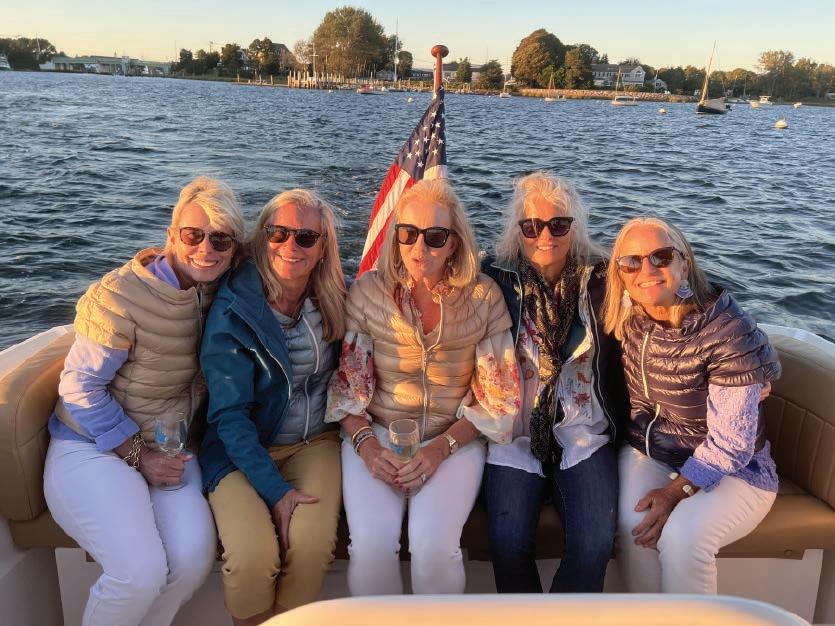
JOHN E. MAHN JR. was appointed to the position of commissioner for the Pennsylvania Fish and Boat Commission (PF&BC) by Pennsylvania Governor Tom Wolf. John will represent eight counties in the southwest corner of the Commonwealth. The PF&BC is the agency charged with preserving the aquatic resources of Pennsylvania.

1971
GEORGE “JERRY” ARNOLD, HOLLY L. SMITH-REYNOLDS, and GEORGE PEABODY got together in September at Jerry’s house in Little Compton, Rhode Island. They took a turn on the seesaw, or as Jerry has termed it, “HeeHaw.” George and Jerry also brought out their instruments. They have played music together since their days at Milton and still perform together locally.

53 Spring/Summer 2023
(Left to right) Jill Shaw Woolworth, Sarah Meeker Jensen, Jane McDermott Hoch, Linda Potter, and Marguerite Bailey Graham; not pictured: Margaret Barron Lawrence
(Left, front to back) 1971: George “Jerry” Arnold, Holly L. SmithReynolds, George Peabody; (right) Mac Cunningham ’68 on right
Class Notes 1966–1971
1974

SARAH (SMITH) FERGUSON
and her husband of 42 years, Rick, moved to eastern Tennessee, just outside Knoxville. Rick retired, but Sarah is still working part-time in diabetes at East Tennessee Children’s Hospital.

1977

ALEXIS “YOSHI” M. BELASH and family drove from their home in Ubud, Bali, to East Java for a 2 a.m. hike up Mount Ijen to see one of the few occurrences worldwide of blue fire, which is burning sulfur gas in a volcanic crater by a sulfuric lake. After a three-week visit back to Milton to see family and friends in September, they returned to Ubud in time to finish building their guest studio and then left for a month in Vietnam. Traveling by sleeper bus and train, they managed to visit 13 locations. Between mu-
seums, ancient sites, palaces, karst mountains, and paddling through caves, they managed to eat their way south from Ha Noi to Sai Gon, with stops in Ha Long Bay, Hoi An, Hue, Dalat, and three cities on the Mekong Delta. It was quite the education. Because they traveled in the off season, they were often the only occidentals.
1978
CHRISTOPHER “CHRIS” HUNTINGTON and his partners at Encap Development have been advising Milton on solar projects and solar credits. He writes, “Coming back to Milton with fresh eyes to the stunning campus and working with COO/CFO Heidi Vanderbilt-Brown and Associate Director for Building Operations Jimmy Benoit has been immensely rewarding. So proud to help Milton take significant sustainability steps and make good on its credo: Dare to cut carbon (and cash) emissions!”
1980
CHRISTOPHER “CHRIS” MYERS is living in Vienna, Austria. He has been married since 2016 to Magdalena Deinhardstein. He and “Leni” would love to hear from Milton friends and to show them why Vienna has been named #1 among world cities for quality of life. Chris is retired and is helping friends in Austria and Spain with splitting wood, harvesting olives, and working in a nearby vineyard. He volunteers at a cooperative supermarket and at the Language Café, a place where people come to learn and practice languages.
a long time. “As many of you know I didn’t say much at all. Go figure I’d be in sales. Lol! The fact that you guys voted me MVP of the hockey team while not getting much playing time meant, and still means, so much to me! You may not even remember, but I will never forget! I want to say thank you from the bottom of my heart! It has showed me that throughout my life if I maintain a good attitude and encourage people around me, people notice, and good things happen. You guys are the best! Great to see a few of you last time I was in Boston!”
JOHN SULLIVAN and Susi, his wife of 31 years, retired in June. John spent most of his career leading the information services departments of various organizations in the Boston area.
FREDERIC “TAD” F. HILLS encourages everyone to “check out Duck & Goose, an animated show based on my book series that is now available on AppleTV+.”
KEVIN MCDONOUGH has wanted to say something to his fellow hockey players from Milton for

54 Milton Magazine
1987
CHRISTINA “CHRISSY” (KAINZ) DEMETREE celebrated the marriage of her daughter, Anna, in Laguna Beach last August.
DEVAL PATRICK ‘74 HONORED


DEVAL PATRICK ’74 was awarded the W.E.B. Du Bois Medal last fall for extraordinary commitment to social justice by Harvard’s Hutchins Center for African and African American Research. The first African American governor of Massachusetts, Patrick was one of seven recipients of the annual award. He is currently professor of the practice of public leadership and codirector of the Center for Public Leadership at Harvard Kennedy School.
1984
RICHARD PERKINS HSUNG’s mother has published two more books in a now three-volume memoir. In the next two installations, Spring Flower, 1951–1970, Facing the Red Storm, and Spring Flower, 1970–2014, Jean Tren-Hwa Perkins, M.D., continues to detail what Helen Zia, author of Last Boat Out of Shanghai, describes as “the remarkable life of a Chinese girl, torn between China and America.” Richard served as editor of all three volumes.
ROBERT “ROB” W. RADTKE walked the 500-mile Camino de Santiago in October and November. Many thanks to all the Milton friends who cheered him on. Robert writes that, “It was great to be in touch with so many classmates via social media.” Anyone interested in his reflections during and after walking the Camino can check out his website, robradtke.com.
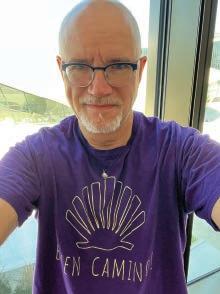
1986
Three members of the class of 1986—DEAN GARFIELD, FARAH PANDITH, and ALLEGRA (GROWDON) RICHDALE—all appeared in the December issue of Washington magazine.
1987
EDWARD “TED” LADD has returned to professing,
teaching platform strategy and economics to MBAs and executives at Hult International Business School, Harvard, and Stanford after several years as the dean of the San Francisco campus and of Global Research at the Hult. He strongly recommends that nobody accept an invitation into academic administration during a pandemic. His next book, Innovating with Impact, will be published by The Economist in March. He and wife, Laura, celebrated their return from San Francisco, to Jackson Hole, Wyoming, with two additions: more guest space and a rescued cattle dog nicknamed Monster. Both welcome visitors for skiing and hiking out the back door.
1988
JONATHAN “JON” LEE departed from Framingham State University in 2018 as a director to live on Cape Cod in Hyannis, Massachusetts. Jon has
now recently moved back to the Greater Boston area to renew his professional life. He hopes that peers—athletes, intellectuals, day students, and others—are thriving.
1991
PRISCILLA ELLIOTT is living in Portland, Oregon, and is happy to report that the second edition of her practical satire book, Tips for the Dark Art of Manipulation: The Sociopath’s Guide to Getting Ahead, will be coming out in paperback in June from Simon and Schuster. She also worked recently as a production designer for several studio films, including Significant Other and Strange Darling.
1993
PRIYA STEPHEN is excited to have moved back to Massachusetts with her family after 22 years away. She joined a pediatric practice in Beverly and
Josie w . Chen / The h arvard Crimson
1982
□ AWARD
Class Notes 1974–1993

K J eld mA honey
School
SHERRY DOWNES ARRIVED at Milton in 1955 and immediately felt at home. With the last polio epidemic raging in Boston, she and her fellow boarders were required to stay on campus. It was that time at Hathaway House where she made long-lasting relationships. “We were all remarkably alike,” she says. “We hit it off immediately, sharing inside jokes and common interests.”
Although the Girls’ School was completely separate from the Boys’ School, Sherry remembers crossing Centre Street for special events. It was at a theater production in March of 1958 that she met a boy, going home that night to write in her diary that he gave her a “nice, warm feeling.” That boy was James Bland, who would become her husband and the father of our current headmaster.
Sadly, James passed away at a young age in 1974. Sherry knew he had Milton Academy in his will, and decided to add the school to her will as well. “I was in my 30s when I added Milton to my plans,” she recalls. “You have to start somewhere. Because we benefited from those who had given before us, we had the advantage of an education worth much more than our parents paid, and the next generations deserve the same.”
Sherry’s gift is not only a tribute to her time at Milton— experiencing an exceptional education that prepared her not only for college but for life—but is also a way of looking forward. “Todd and his wife, Nancy, have done an amazing job
of creating a community at Milton,” she says. “The community and diversity that have been built under his leadership are something that will last.”
She also has great confidence in the current and future students of Milton, including her grandchildren Nicholas, Emily, and Mary. “These kids are the future,” she says, “They want to save the world—and I think they can!”
Sherry is right. Our students are bright and determined, the leaders of the future. And your forethought and generosity can help them achieve new heights. Consider including Milton Academy in your will or trust, or as a beneficiary of an IRA, 401(k), or other retirement asset. To explore your options or share your intentions, please visit miltonplannedgiving.org/give or contact our Office of Development at any time.
James Barrett Director of Planned Giving James_Barrett@milton.edu
617-898-2376
Sherry Downes ’58, mother of Head of
Todd Bland, speaks about legacy.
Salem and is currently living in Lexington. Enjoying the chance to reconnect, she and TRAVERS RICKERT hike or do a yoga class together.
ARYEH STERNBERG helping break language barri ers globally with KUDO, bringing United Nations grade interpreta tion to platforms like Zoom and Microsoft Teams. The platform was recently used by the Council of Europe to enable President Zelensky of Ukraine to address the people of the world in more than 15 languages simultaneously. Aryeh looks after the Asia sales activity from Sydney,
JERRYANNE “ANNIE”
JEAN-BAPTISTE was recently named to the Ebony Power 100 list. Thie list represents 100 powerful Black leaders across the world. Annie was featured as a “business disruptor” for her groundbreaking work creating the product inclusion and equity practice, which has scaled across the tech, finance, medicine, and fashion industries. Annie has also recently launched a LinkedIn learning course on equitable design practices. The course is focused on helping organizations build inclusive and equitable products across various industries. You can find it by searching Equitable Product Design on LinkedIn learning.
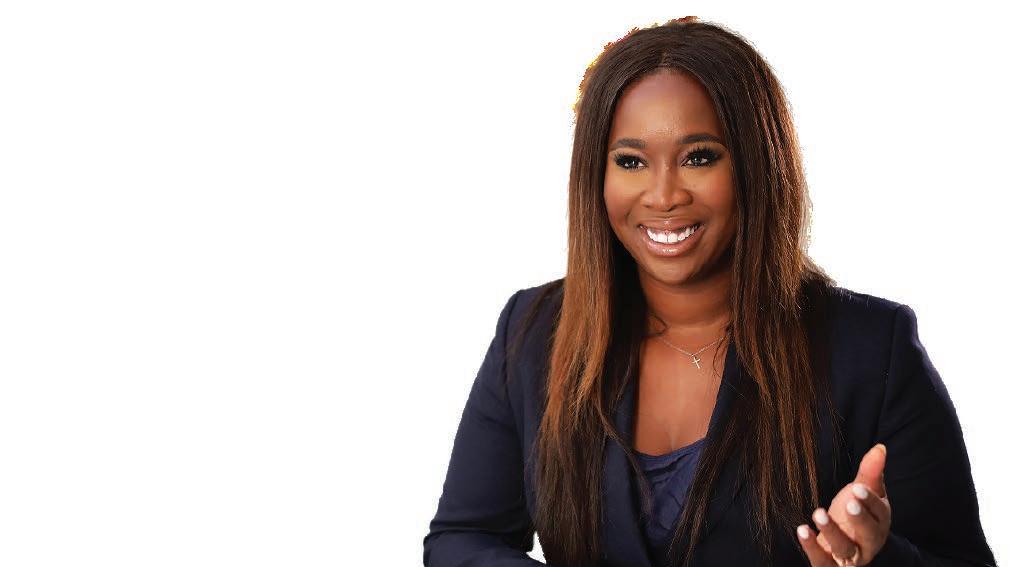
2006
Australia, where he lives with his wife, Marcia, and daughter, Isabella.
1998
CHAD BRIGHT-REASON and his DONNA BRIGHT ’78, have created a nonprofit organization rooted in using tennis as a vehicle to help at-risk boys of color navigate the world of junior tennis and beyond. A Bright Future provides wraparound services, including full financial assistance for tennis, mentorship, cultural identity training, and fraternity. Donna serves as president and Chad as board member/program TROY CRICHLOW ’99 is also a member of the board. Check out all the work they are doing at abrightfuture.org.

and DANIEL are thrilled to announce the arrival of their daughter, Zadie Wilde Dupree Adair, on January 24, 2022. She is growing like a weed and already
loves events of any kind, especially Halloween.
SARAH (MCGINTY) LONDON was named to Fortune’s 2022 Most Powerful Women in Business. Centene Corporation, where Sarah serves as CEO, noted that “this recognition is a testament to Sarah’s leadership and ability to inspire our team members to deliver on our purpose of transforming the health of the community, one person at a time.”
YAN (CHUNG) LAN helped plan a festive Thanksgiving gathering hosted by the Milton Academy Alumni Association in Hong Kong. Everyone had a wonderful dinner and caught up with both old and new friends of Milton.

1999
ANDREW “ANDY” HOUSTON and his family, Katie, Lucy, and Maximo, moved to McKinney, Texas, in late 2021. Andy accepted a role leading Chubb Insurance’s middle market division in the Southwest. Lucy is 13 and enjoys softball. Max is 11 and loves playing his guitar. To help with the transition, the family added a new golden retriever, Tucker.
2002
NAFEESAH ALLEN, PH.D., recently published dual language children’s books that rhyme in English, Spanish, and

Class Notes 1993–2002
PRUDENCE TSANG and GRACE TIN
Donna Bright ’78, Chad BrightReason ‘98
Prudence Tsang ’98 and Grace Tin Yan (Chung) Lan ’98
A STORY OF FAMILY SEPARATION
Inspired by the story of an English child who attended Milton Academy during World War II, LAURA SPENCE-ASH ’77 has written her first novel, Beyond That, the Sea. It tells the story of Beatrix, an 11-year-old sent to live with the Gregory family in America to escape the German bombing campaign in England, at different times in her life. Spence-Ash spoke to Milton Magazine about what led to her debut book, the “iron will” of her main character, and her own experience as a child living away from home.
What led you to become a firsttime novelist at this stage of your life?

I wrote in college and always planned on returning to writing, but somehow never found the time. But when my children were nearly grown, I went back to school and got an M.F.A., and then worked as an editor
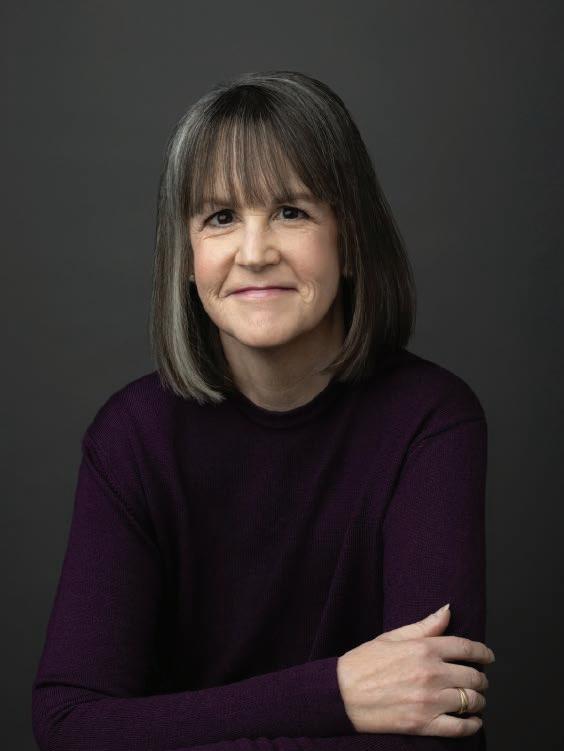
and freelance writer. I had been thinking about and working on this novel for years, but I finally figured out how to tell the story.
How did you come up with the idea for the book?
I read an article in The New York Times in 1998 about a group of older adults who returned to the States to see where they had lived during the war. I had no idea that children were sent alone across the sea. I was fascinated by that and couldn’t stop thinking about it.
What research did you do to present the story and historical period in a way that seemed true to life?
I did a fair bit of research about the evacuees and the Blitz early on, including reading a memoir called See You After the Duration, by Michael Henderson ’49 He had been sent to Boston and ended up with a family in Milton, attending Milton Academy. That helped his story come alive for me. As I wrote the novel, I would do deep dives into certain time periods to help develop the narrative world.
Why did you decide to structure the book with each chapter from the perspective of a different character?
I thought of this book as the story of two families over time, so it was important to me to present multiple points- of- view. I wanted to understand the im-
pact on all involved when families are broken and remade.
What do you think Beatrix’s life would have been like if she hadn’t gone to America during the war?
I love this question! Beatrix has a bit of an iron will, and I think she would have made the most of her life, no matter where she was. But the thought makes me sad—she never would have met the Gregorys or spent summers in Maine.
You didn’t have the same experience as Beatrix, of course, but you did live away from your parents as a boarding student at Milton. How did that experi-
ence influence your life?
I do think being away from home at that age creates a unique bond with those around you, one that stays with you over the years. Our class was very tight (and rebellious!), and I have enjoyed reconnecting with people at reunions and over social media. I feel close to many in my class, and I love Boston; it feels like home.
What are your aspirations for your writing in the future?
I am working on another novel, and I’m also writing short stories, critical essays, and reviews. I hope Beyond That, the Sea is the first of many books!

Beowulf s heeh A n 59
□ ALUMNI BOOKS
Spring/Summer 2023
In Memoriam
2007: Jacquie Macdonald, Molly McDermott, Alex Bean, and Annie LaVigne recreated a childhood photo at Annie’s wedding in Baltimore.

Class of 1941
Alexander G. Rogerson
Class of 1948
Robert G. White
Class of 1950
Marion Thompson Adams
Nancy Burley Chase
Class of 1952
Dorothy Newbegin Davis
Sarah North Hillyer
Class of 1953
Eberhard Faber IV
Robert S. Freeman
Class of 1955
Isabelle Cook Pratt
Edwin L. Prien, Jr.
Class of 1956
Martha Lincoln Smick

Vcevold O. Strekalovsky*
Class of 1958
Deborah Cutler Riveros
Class of 1959
Anne Weld Collins
Class of 1960
Sargent Collier
Class of 1963
Henry G. Beyer
Class of 1966
James M. O’Brien
Class of 1973
Robert K. Lamere
Former Trustee
Merloyd Lawrence
Faculty and Staff
Walter A. Sedelow, Jr.
* FORMER TRUSTEE
ALUMNI, FACULTY, AND STAFF WHO PASSED JUNE 21, 2022 - DECEMBER 1, 2022. TO NOTIFY US OF A DEATH, PLEASE CONTACT THE DEVELOPMENT AND ALUMNI RELATIONS OFFICE AT ALUMNI@MILTON.EDU OR 617-898-2447.

Portuguese. These books are ideal for children under age eight or new language learners of any age. She also recently published her first full-length academic book, Indo-Mozambicans in Maputo, 1947-1992, with Palgrave. Libraries and institutions are welcome to requisition. All titles are available on her website, www.nafeesahallen. com, and she is scheduling book readings and talks for 2023.
SETH MAGAZINER was recently elected to represent Rhode Is-
land’s Second District in Congress. He is grateful for the support of the Milton community during his campaign and encourages every-
one to reach out if visiting Washington, D.C., or Rhode Island.
MAE RYAN is now producing projects for TV and film after working in journalism for many years. She recently produced the HBO documentary series Sex Diaries and is currently working with A24 on feature films. Outside the production world, Mae married Steven Grisé in the middle of their pond in the Hudson Valley, surrounded by wonderful friends, family, and a lot of fire.
2006
RACHEL SCHWERIN married Jay Lurie on September 4, 2022, in Ithaca, New York. At the reception, LORA-FAYE WHELAN performed a remarkable rendition of Brandi Carlile’s “The Story,” as was promised decades ago on the porch of Robbins House.
2007
2010
ALEXANDRA “ALEX” BEAN, ANNA “ANNIE” LAVIGNE, JACQUELINE “JACQUIE” MACDON-
60 Milton Magazine
MELISSA SANTOS wed Christopher Howard on July 1, 2022, at a lovely ceremony in Kenilworth, New Jersey.
Notes 2002–2008
Class
reunited to celebrate Annie’s marriage to David Cholewczynski on September 10, 2022. Annie is currently chief resident in radiation oncology at Johns Hopkins, where she will join the faculty following her residency graduation, next June. She and David live in Baltimore with their adopted greyhound, Lyra.
FRANK SMITH IV has released the first three episodes of his LGBTQIA+ comedy series, Open To It, featuring Laganja Estranja, Manila Luzon, Honey Davenport, and Pandora Boxx of Rupaul’s Drag Race. Watch at opentoitseries.com.
2008

ROBERT “ROB” WOODHOUSE has never gotten around to submitting a class note since graduating, and now it’s his 15th Reunion, so he is going to sum it up as best he can: “Went to Colby, graduated with history degree, worked at Wayfair, moved to NYC, got married to Colby girlfriend, moved into consulting, bought a home in NYC, accumulated three cats, traveled a lot, now director at a consulting firm.” There, that’s 15 years in 37 words. He hopes to see lots of ’08 classmates in June for Reunion!
Milton Academy Board of Trustees 2022-2023
Claire D. Hughes Johnson ’90 P ’24 ’27
Stuart I. Mathews P ’13 ’17 ’17 Vice President Waban MA
Edward E. Wendell Jr. ’58 P ’94 ’98 ’01 GP ‘35
Bradley M. Bloom P ’06 ’08
James M. Fitzgibbons ’52 P ’87 ’90 ’93 Emeritus Chestnut Hill MA
Franklin W. Hobbs IV ’65 P ’98
David B. Brewster ’90 P ’25 Cambridge MA
Yeng Felipe Butler ’92 P ’25 ’33 Milton MA
Douglas Crocker II ’58 Delray Beach FL
Jason Dillow ’97 New York NY
Shadi Farokhzad P ‘23 ‘25 Waban MA
John B. Fitzgibbons ’87 Bronxville NY
Eleanor Haller-Jorden ’75 P ’09 Wädenswil Switzerland

Peter Kagan ’86
Sonu Kalra P ’23 ’26 ’28
York NY
Milton MA
Elizabeth B. Katz ’04 Boston MA
William A. Knowlton P ’23 Boston MA
Yunli Lou ’87 P ’24
Ravi Mallela P ‘22, ‘24
John D. McEvoy ’82 P ’19 ’20 ’25
Meika Tylese Neblett ’90
Osaremen Okolo ‘13
Gene Reilly ’79 P ’10 ’12
Hendrick Sin P ’23 ’25
Gabriel Sunshine P ’22 ’24
Patrick Tsang ’90
Luis M. Viceira P ’16 ’19
Justin Walsh ‘99
Sylvia P. Westphal P ’18 ’21 ’25 ’27 ’27
Ronnell L. Wilson ’93
Helen Zhu P ’25
Shanghai China
Honolulu HI
Milton MA
Lincroft NJ
Cambridge MA
North Andover MA
Hong Kong China
Boston MA
Hong Kong China
Belmont MA
New York NY
Boston MA
Jersey City NJ
Hong Kong China
61 Spring/Summer 2023
President Milton MA
Vice President Milton MA
Emeritus Wellesley MA
Emeritus New York NY
New
Lora-Faye Whelan ’06 (right) entertains at the marriage of Rachel Schwerin ’06 to Jay Lurie.
2011
JOHN “JACK” MITCHELL married Daeyoung Lim this past September on a farm and brewery in Poughkeepsie, New York. Jack met Daeyoung in Connecticut after coming back to the area for the first COVID-19 lockdown. AINIKKI-HELENA “AINIKKI”
RIIKONEN, EMILY PERKINS ’10, and RYAN MCDANIEL ’10 were all at the wedding. Jack is still living in Connecticut while his husband completes his Ph.D. at UConn. Jack is currently working as a staff attorney at the state legislature in Hartford.

2010
ANISHA CHAKRABARTI, who was previously the deputy communications director for former governor Charlie Baker, got married in December, and Governor Baker officiated at the ceremony.
2011
WILLIAM “CLINT” MCSHERRY III has reached some personal and professional milestones. Clint has earned a Certified Hazardous Materials Manager certificate and has started a new job working for Duke University’s environmental programs division, ensuring compliance with state and federal regulations. Clint also received recognition in the American Ultimate Disc League, earning a spot on the week 5 league-wide Honor Roll and finishing the season in the top 10 for throwing yards per game.
2012
GREGORY BLAIZE received the 2021 Federal Bureau of Investigation Director’s Leadership Award for Boston, Massachusetts, in a ceremony that took place this past December.
2013
OSAREMEN OKOLO moved back home to Massachusetts in August 2022 and returned to Harvard as a Ph.D. student, Presidential Scholar, and Paul & Daisy Soros Fellow. She begins her doctoral studies after five immensely rewarding years living in Washington, D.C., first working on the Senate HELP Committee with Chair Patty Murray’s health policy team, and then shifting to the House side as Congresswoman Jan Schakowsky’s senior health policy advisor. Most recently, Osaremen served in the White House Office of the COVID-19 Response.
John “Jack” Mitchell ’11, Ainikki-Helena “Ainikki” Riikonen ‘11, Ryan McDaniel ’10, and Emily Perkins ’10
2014
MICHAEL “MIKE” CRONIN shared that he passed the bar exam and has been sworn in as an attorney.

ALEXANDER “ALEX” LEE, NATHANIEL “NATE” LUNDIE, and GEOFFREY “GEOFF” OWENS proved the distance between the coasts is just a number and met up in the middle for some time in Park City, Utah.
2015
ALEXANDER “MINH-ANH” DAY wrote (in iambic pentameter), directed, and produced the play, “Thirteenth Night,” which was featured at the New York Theater Festival’s Fall/Winterfest in October 2022. Other members of the Class of 2015, as well as TÂM-ANH DAY ’12, showed their support for their classmate at the festival. Left to right: SOPHIE KAUFMAN ‘15, GISELLE PRADO ‘15, SANTIAGO VIVAR ‘15, MINH-ANH DAY ‘15, ZARIA SMALLS ‘15,and ELLIOTT TÂM-ANH DAY ‘12 (not pictured: CONOR STEWART ‘15)

62
Class Notes 2010–2015
ognizing that it is hard to determine the “right”’ path forward without taking the time to genuinely seek to understand, to actively listen to what is being said, and to appreciate different perspectives. The positive impacts of Todd’s “‘eq” are needed now more than ever. Not only at Milton but, more important, in the world beyond Milton.
So often outstanding leadership comes from the right person, in the right place, at the right time. Todd’s tenure at Milton embodied this notion. And with the benefit of hindsight, I wouldn’t have voted any other way back in 2008. Todd was the right person in the right place at the right time to lead Milton for the past 14 years. Our community, our school, and I personally are the better for it.
We put ourselves into our life’s work, and education is Todd’s life’s work. We want to know that we made a difference. That we had a positive impact on the people around us. That we left a place better than when we came. Todd should be proud of all that he accomplished as Milton’s 12th head of school—proud of the indelible imprint he left on our school and our community. I know I am. And I have a good feeling that Sherry and James would be too. The Bland family legacy at Milton added a wonderful chapter.

LISA

Postscript CONTINUED FROM P. 64
63 Spring/Summer 2023
DONOHUE ’83, ELECTED TO MILTON’S BOARD OF TRUSTEES IN 2008, SERVED AS PRESIDENT OF THE BOARD FROM 2015 TO 2022. A FORMER MARKETING EXECUTIVE FOR PUBLICIS GROUPE, THE WORLD’S LARGEST COMMUNICATIONS COMPANY, SHE NOW SERVES ON SEVERAL CORPORATE BOARDS.
Clare Liberty Brown DAUGHTER OF SUSANNAH (STONE) BROWN ’05 AND HER HUSBAND, GARDNER FRANCHOT BROWN
N.K.O.T.Q.* *New Kids on the Quad ALUMNI FAMILIES & THEIR LATEST ADDITIONS
Theodore “Teddy” Berns Keefe SON OF JAMES KEEFE ’09 AND HIS WIFE, ALEX
Head of School Leaves Lasting Imprint
TODD BLAND ’S SUCCESSFUL TENURE AS MILTON’S HEAD OF SCHOOL IS THE RESULT OF A UNIQUE BLEND OF TALENTS, SAYS FORMER BOARD OF TRUSTEES PRESIDENT LISA DONOHUE ’83.
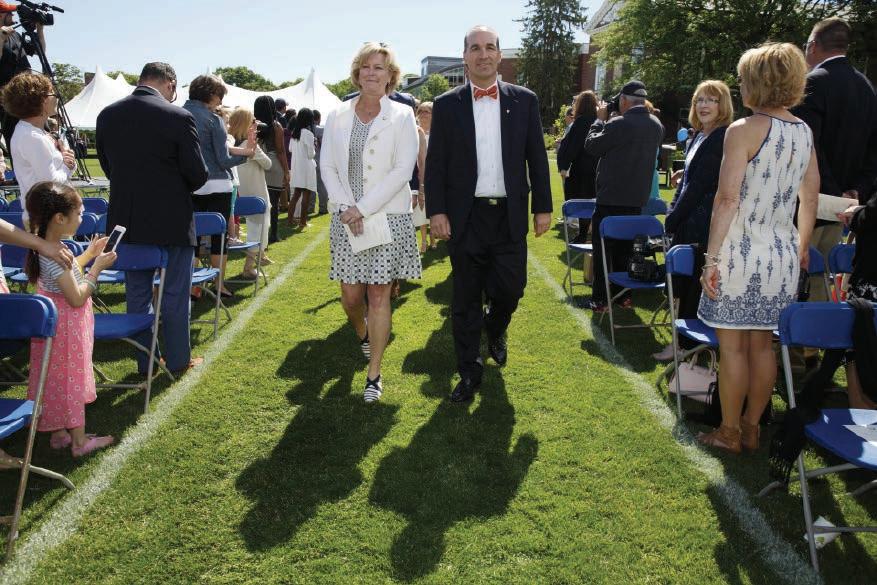
I stIll remember the moment as if it were yesterday. Spring of 2008, and I was a new trustee at Milton Academy, participating in my first official vote. But it wasn’t just any vote, it was a vote to appoint a new head of school. Heady stuff, so to speak. No small amount of pressure to make the right decision. When it was over, Todd Bland was appointed as the 12th head of school in the school’s history.
While I didn’t know Todd personally, he came to Milton with impressive credentials and vast experience in secondary school education. But he also came with a special connection. His parents Sherry and James met at Milton—both members of the Class of ’58—and his father is memorialized on campus in Apthorp Chapel. We always want to excel in new endeavors and push ourselves to succeed, and Todd was no different. He just had a little extra pressure, given his family legacy. But in classic Todd style, he was undaunted and in fact embraced it.
Over the next 14 years, I had the pleasure of working closely with Todd as a trustee and even more closely, beginning in 2015, as Board president. I got to know Todd the person: what makes him tick, what inspires him, where he draws his strength. And that was the real privilege.
The accolades of Todd’s tenure are many—strategic planning, the Dare Campaign, curricula renewal, deij, our outstanding faculty, and of course our amazing student body—to name a few. All strategic and intelligent or (iq) driven successes. Smart, purposeful leadership with an eye toward ensuring Milton’s future. Milton achieved
many milestones under his leadership. And while not easy, these milestones were all opportunities.
But back in 2008, no crystal ball could have forecast all the challenges that Todd would face as well, or the impact they would have on our community. A financial crisis, a global pandemic, racial injustice, a sexual-misconduct reckoning, a war in Ukraine. Challenges that on one hand, were macro and global in nature, and on the other hand, deeply personal and painful on an individual level.
And it is here where Todd made the most impact, not only on me but on the entire Milton community, driven by his eq side. Much is written these days regarding the importance of emotional intelligence in strong and effective leadership. Todd was way ahead of the game on this one, and it became an indelible mark of his tenure.

Todd attacked each of these challenges head on, guided by his North Star, his emotional connection to people. He steered Milton through some of our toughest challenges, and through it all, reminded us of the importance of caring, of acknowledging the human ethos in every situation, and of always, always leading with kindness.
Todd’s emotional quotient also translated to a strong educational quotient. And while one might assume that to be a given in an educator, this was yet another area where Todd excelled. From the moment he arrived on campus, he exuded both passion and patience—a passion for education and a patience for the education of children. He applied his patented “appreciative inquiry,” rec-
64 Postscript
CONTINUED ON P. 63 Milton Magazine
m i C h A el dwyer
“Todd’s emotional quotient also translated to a strong educational quotient.”
LISA DONOHUE ’83
SPRING@MILTON
GET READY FOR GIVING DAY ON MARCH 9
24 hours. Nine challenges. Imagine the possibilities!
Join fellow alumni, parents, and friends as we unite around a common goal: supporting Milton Academy.
Visit give.milton.edu/giving-day-2023 to see what’s possible with your gift to Milton on Giving Day.
SAVE THE DATE FOR
reunion
Join us Friday, June 16, and Saturday, June 17, 2023.
Classes ending in 3 and 8: Mark your calendar. Connect with friends. Make your next Milton memory by joining us for your Reunion.
Visit www.milton.edu/reunion to register today.

JOIN MILTON ON THE ROAD AND ONLINE
With a calendar of receptions across the country and intriguing virtual speaker events, there are so many ways to engage with Milton this spring.

Visit www.milton.edu/graduates/events-calendar to see our full events calendar.




“Much is written these days regarding the importance of emotional intelligence in strong and effective leadership. Todd was way ahead of the game on this one, and it became an indelible mark of his tenure.”
Milton Magazine Milton Academy Communication Office Milton,
LISA DONOHUE ’83 , FORMER PRESIDENT OF THE MILTON ACADEMY BOARD OF TRUSTEES (SEE PAGE 64)
MA 02186
Non-Profit Organization U.S. Postage PAID Boston, MA Permit No. 58423
Change Service Requested






































 Located among boutiques, restaurants, antiques shops, and antiquarian book stores, DeLuca’s Market, at 11 Charles Street, has been a mainstay for Beacon Hill’s residents, tourists, and workers at neighboring institutions.
Located among boutiques, restaurants, antiques shops, and antiquarian book stores, DeLuca’s Market, at 11 Charles Street, has been a mainstay for Beacon Hill’s residents, tourists, and workers at neighboring institutions.







































































